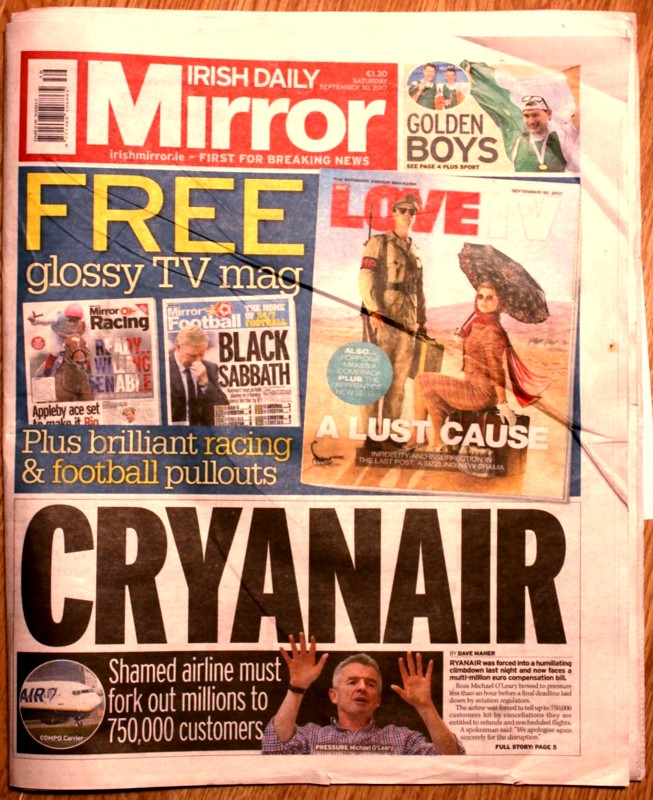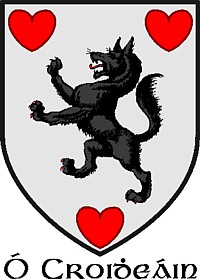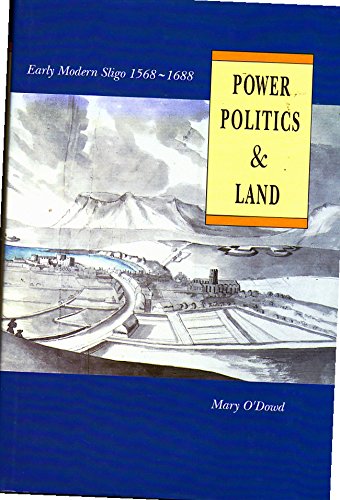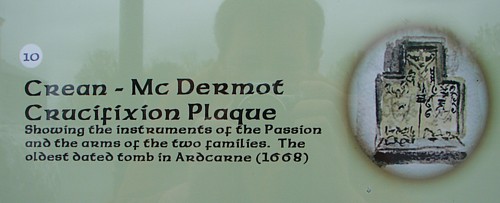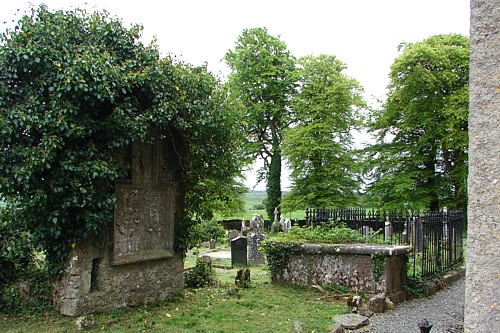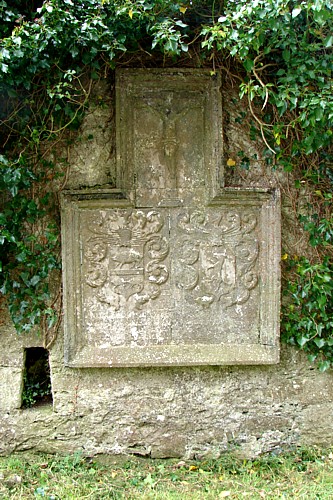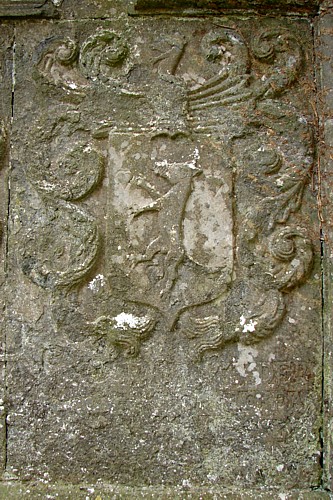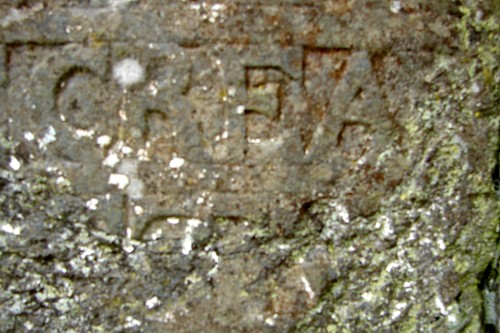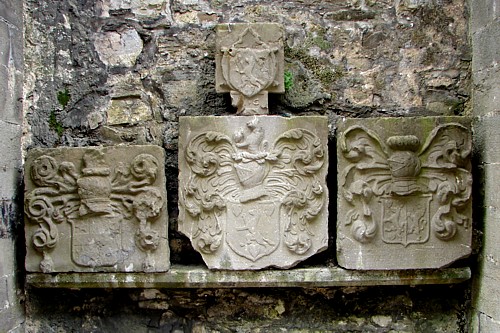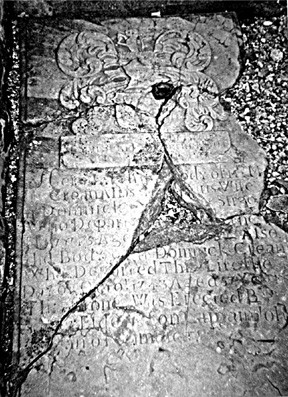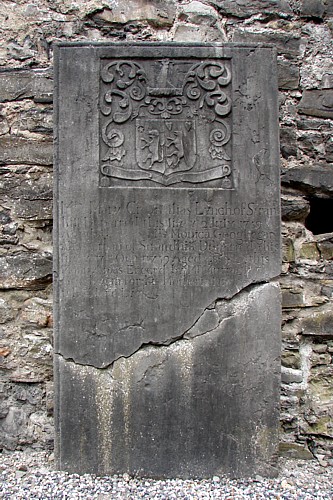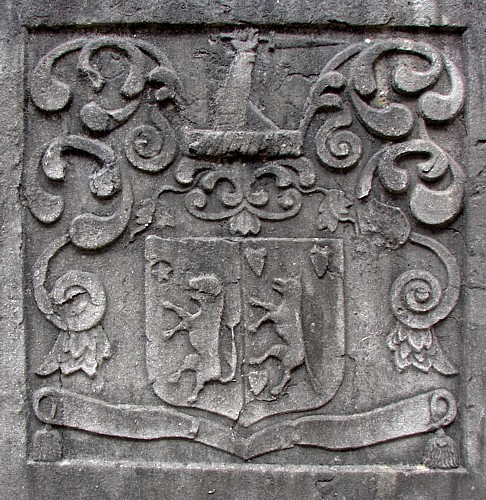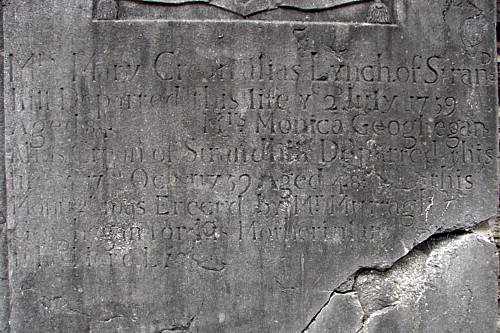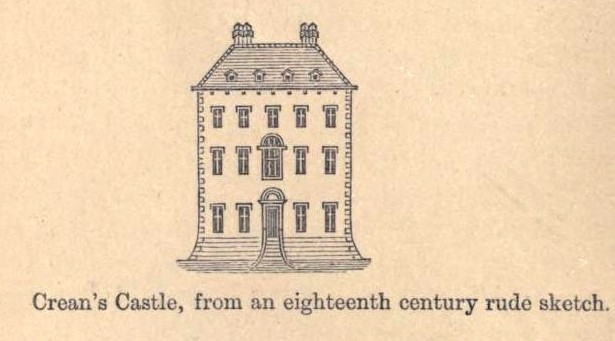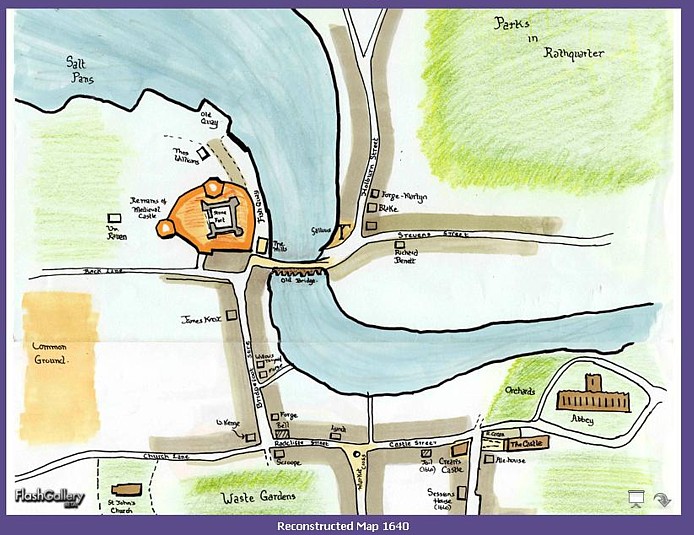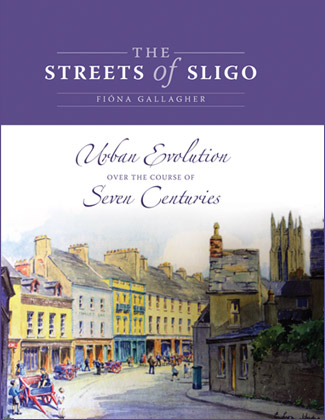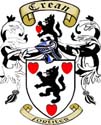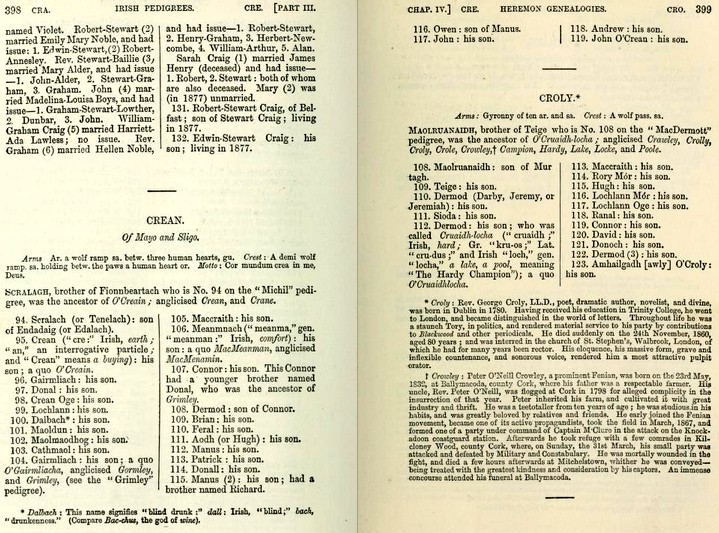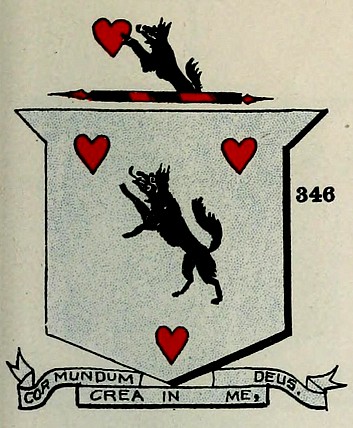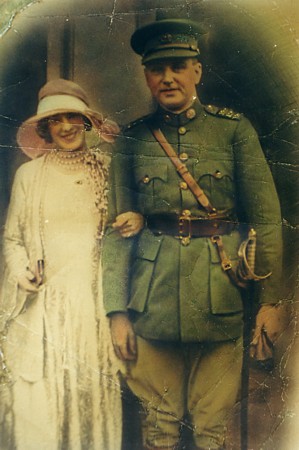| Surname, Forenames | War | Regiment / Service | Site | Memorial |
|---|---|---|---|---|
| Crean, Francis | WW I | Not stated | Clongowes Wood College | Clongowes Great War Memorial |
| Crean, Francis | WW I | Not stated | Enniskillen, Portora Royal School | Clongowes College Great War Memorial |
| Crean, James | WW I | West Yorkshire Regt. | Castlebar, Mayo Peace Park | Mayo Great War Memorial |
| Crean, T. | WW II | Merchant Navy (Irish) | Dublin 02, City Quay | Irish Merchant Navy Memorial |
| Crean, T. J. | WW I | Not stated | Dublin 04, Wanderers Rugby Football Club | Wanderers R.F.C. Great War Roll of Honour |
| Creane, John | Civil War | Irish Republican Army | Wexford, Republican Garden | Parle, Crean & Hogan Memorial |
| Creane, John (Seán Croidheáin) | Civil War | Irish Republican Army Charman Teas Brigade | Taghmon | Civil War Memorial |
| Creaney, Felix | WW II | Not stated | Lurgan, Church Place | Lurgan War Memorial |
| Creaney, J. | WW I | Not stated | Lurgan, Church Place | Lurgan War Memorial |
| Creaney, Shaun | WW II | Not stated | Lurgan, Church Place | Lurgan War Memorial |
| Creaney, Thomas | [-] | Irish Republican Army Castlegregory (4th Btn.) & Dingle (5th Btn.) | Ballyseedy, Co. Kerry | Ballyseedy Republican Memorial |
| McCreanor, G. F. | WW II | Not stated | Banbridge | Banbridge War Memorial |
| McCreanor, M. | WW I | Not stated | Banbridge | Banbridge War Memorial |
| McCreanor, P. | WW I | Not stated | Lurgan, Church Place | Lurgan War Memorial |
Ó Croidheáin
|
|||||||||||||||||||||||||||||||
This page is maintained by Caoimhghin Ó Croidheáin (Kevin Cryan) who can be contacted through his art website at http://gaelart.net/ Latest update: 18 / 6 / 2023
|
| 1562 | 1594 | Andrew O'Crean, O.P. | Appointed on 28 January 1562. Died in office in 1594. |
https://en.wikipedia.org/wiki/Bishop_of_Elphin
Bishop of Elphin throne?
Croghan Throne pictures
The Irish Dominicans,
1536-1641
by Thomas Flynn
ANDREW O'CREAN
ANDREW O'CREAN, BISHOP OF ELPHIN (1562-94),
AND THE CONFLICT OF ECCLESIASTICAL JURISDICTIONS
That Andrew O'Crean owed his promotion to Elphin in 1562 to the pragmatic
judgement of David Wolfe is clear from one of Wolfe's letters to Rome, dated 12
October 1561:
"Bernard O'Higgin, Bishop of Elphin, had resigned his see in favour of a
Dominican, Andrew Crean, the prior of Sligo, a man of piety and sanctity, who is
moreover held in great esteem by the laity, not so much for his learning as for
his amiability and holiness. The said Bernard was a good and religious man in
himself, but he was not acceptable to the people. Seeing that he was losing the
temporalities of the see through this dislike which the people had for him, he
chose Father Andrew, who is beloved by everyone, that thus all that was lost
might be regained. Father Andrew now goes to Rome, with the permission of his
provincial, to obtain that see,
[76 Cal. Pat. Rolls Ire., las. 1, pp vii, 5. 77 Lynch, De Praesulibus Hib., ii,
342. 78 ASV, Archiv. Arcis, XIV, 11, vol. 41, f. 68r: `Acculen. eps. ord praed
strenuus catholicae ficlei propugnator.' The details of O'Hart's career set out
above disprove the inaccurate assertion made by S. Ellis that the bishop
'managed to remain acceptable to both sides', namely pope and queen. See S.
Ellis, Tudor Ireland, 1470-1603, London 1985, 197. 79 P. O'Sullivan Beare,
Selections firm the Zoilomastix, ed. and trans. T. J. O'Donnell, Dublin 1960,
21. Similar tributes in A. Femandes, Concenatio Praedicatoria pro Ecclesia
Catholica, Salamanca 1618, 282; A. De Altamura, Bibliothecae DOMilli-canae, Rome
1677, 434, 538; G. M. Cavalieri, Galleria de'Sommi Pontefici, Benevento 1696,
407.]
bearing with him the resignation of the said Bernard. Father Andrew asked me for
testimonials, and though I personally know little about him, I can attest to the
reputation for virtue which he enjoys through-out the country."
Andrew O'Crean's Augustinian predecessor, Bernard O'Higgin, quitted Ireland
definitively for continental exile in about 1554. This had caused a serious void
in the diocese of Elphin. Bishop Roland Burke, who had been papally appointed to
Clonfert in May 1534, had sub-sequently surrendered his bull of appointment in
order to receive the temporalities of the see from Henry viii. During O'Higgin's
absence from his diocese Burke was nominated Anglican Bishop of Elphin on 23
November 1551. From this point it became imperative for Rome to install an
effective Catholic bishop to counter Burke's influence, excep-tionally strong in
the southern part of this important diocese. A recent study has shown that a
vital factor in O'Crean's nomination was the local socio-political support which
his predecessor had lacked.
O'Crean was evidently very acceptable 'to the people', most of all to the ruling
Irish lords and the leading merchant families of Sligo. `O'Crean was a member of
the well-known Gaelic merchant family at the port of Sligo, where the fish trade
was the lucrative industry.'8' The O'Creans were second only to the O'Connors
Sligo, and with them had learned to survive and thrive between the two powerful
lay lords contending for control of the area, the O'Donnells of Tyrconnell or
north-west Ulster and the Mac-William Burkes of Lower Connacht." As prior of
Sligo abbey, Andrew O'Crean belonged to the most important of five Dominican
houses in the extended diocese of Elphin, stretching from Sligo to Athlone.
In the late autumn of 1561 O'Crean set out for Rome with Eugene O'Hart to obtain
the letters of his appointment to Elphin. While passing through France he fell
ill, and being unable or unwilling to travel further he remained in France until
the bull of his appointment reached him." Made bishop by papal provision (28
January 1562) in the same consistory
[80 Cited by Moran, Archbishops of Dublin, 417-19 (trans. 85-7) at 85. Fora
summary of his episcopate see P. F. Moran, 'The See of Elphin in the Sixteenth
Century' in IER, 1st ser., 2 (1866), 152-4. 81 Martin, 'Confusion Abounding',
70-76. 6 Croidhelin (O'Crean) was the name of a family of Cinel Eoghain who in
the sixteenth century settled at Sligo, where they prospered as merchants, and
afterwards acquired a considerable amount of landed property in the area. Woulfe,
Sloinnte Gaedhael is Gall, 484; see also Anndla Uladh, Annals of Ulster, ed. W.
M. Hennessy and 13. MacCarthy, iii, Dublin 1895, 482, 572-4; Annals of Loch Ce,
ed. W. M. Hennessy, ii, Dublin 1939, 512; Cal Pat. Rolls Ire., Jas 1, 20, cited
in NHL, iii, 15. 82 Martin, 'Confusion Abounding', 81-2. 83 Lynch, De
Praesulibus Hib., ii, 291.]
that named O'Hart to Achonry, O'Crean returned to Ireland without participating
in the last sessions of Trent (1562-3). Later, in common with his fellow bishops
of Achonry and Killala, O'Crean accepted the decrees and legislation of the
council as normative for Catholic life and practice in Connacht. This decision
was given concrete effect in marriage procedures, where all three dioceses
decided on a uniform policy con-cerning the conditions for the validity of
sacramental marriages and the banning of clandestine ones.84 It has been
suggested that O'Crean's active government did not extend outside the northern
portion of his diocese, where he would have had the open assistance of his own
kinsmen and that of the O'Connors, and that Roland Burke, the Anglican nominee,
exercised more than a nominal control over the rest of the see, with the weight
of his Clanwilliam supporters behind him."
This is simply surmise, perhaps accurate or quite inaccurate. The truth is that
there is no firm evidence one way or the other on which to base a reliable
judgement. Andrew O'Crean lived mostly in Sligo abbey, whose fine church he
designated the cathedral church of Elphin.86 For the most part he was left
undisturbed by the reformers or by sporadic attempts to introduce Anglicanism on
the part of officialdom. Bishop Roland Burke's death in 1580 may have prompted
O'Crean to assert full jurisdiction over the whole diocese, especially in the
matter of the temporalities, a significant portion of which may have been
retained by Burke. The issue may have become more pressing with the appoint-ment
of John Harvey, an Englishman, as administrator, who was granted the diocese 'in
custodium' by royal letters patent in 1582.87
An entry under this same year in the Annals of Loch Ce suggests that O'Crean
sought some form of recognition from the Dublin government: 'The bishopric of
Elphin (Olifinn) was given to Andrew O'Craidhen by the Council of Eirinn at
Ath-Cliath.'88 What O'Crean in fact was seeking was confirmation for the
totality of the diocesan revenues, thereby accepting them as the gift of the
crown. There was no hint of temporising or of external compliance with
Elizabethan religious policy on the part of O'Crean, otherwise this would have
been dolefully chronicled by the Annals of Loch Ce or mentioned in the
contemporary State Papers. It is on record that he consistently and strenuously
refused to take the Oath of Supremacy." The mentalities and the complexities
surrounding
[84 Ibid. 85 Martin, 'Confusion Abounding', 71. 86 ASV, Reg. Suppl., 3401, f.
61v. 87 J. Ware, The Whole Works of Sir James Ware concerning Ireland, ed. W.
Harris, i, Dublin 1739, 634. 88 Annals of Loch CE, ii, 455. 89 Lynch, De
Praendibus Hib., ii, 291.]
so many issues of the age may not be perfectly definable or capable of proof,
but the appointment of another Englishman, Thomas Chester, as Anglican Bishop of
Elphin, who died shortly afterwards in June 1584,90 speaks for itself. Had
O'Crean really temporised, Chester would not have been named Bishop of Elphin.
When Lord Deputy Sidney and his retinue had encamped in O'Connor Sligo's country
on 21 October 1566, `O'Connor Sligo came unto us with the Bishop of Elphin, most
humbly offering service and fealty to your majesty and all courtesy to us.'91
His conduct on that occasion illustrated his diplomatic and conciliatory
character, but this could hardly be described as displaying evidence of
compromise or vacillation. Thomas Burke, author of Hibernia Dominicana, referred
to O'Crean as 'Andrea Xerea',92 which may indicate that O'Crean once studied at
Jerez de la Frontera in the south of Spain. Beyond this designation, Burke had
nothing further to say of O'Crean's episcopate. He was at some stage of his
career awarded the degree of master of theology, which in that era would
indicate that he was a trained theologian. He was respon-sible for the erection
of a marble cross (Leacht an Easpaig) in the town of Sligo.93 Towards the end of
his life he retired from the active admin-istration of his see and lived quietly
with his Dominican brethren, having earned for himself a reputation for
sanctity. He died at Sligo in 1594, in the midst of his fellow Dominicans, who,
through the influence of Domhnall Mar O'Connor, enjoyed comparative tranquillity
and security.
Almost certainly Andrew O'Crean was buried in the Dominican church, his
'cathedral'. It was this same prominent O'Connor who was regarded with such
favour by Elizabeth that when he refused the title of earl she gave him the
right to be styled The O'Connor of Sligo. It was through his intervention that
an order was issued prohibiting the destruction of Sligo abbey. This was typical
of the policy of compromise and con-cession made by English officialdom in
Elizabethan Connacht. Lynch concluded his biographical notice on O'Crean by
adding a most valu-able and telling comment on current Elizabethan religious
policy in Sligo: it was the custom that those who had received holy orders
during Mary's reign were not compelled `to change their habit' or go into exile;
and hence it was that Andrew O'Crean was not in the least molested once he
stayed within the walls of his Dominican monastery of Sligo." Andrew O'Crean's
episcopate differed notably in style and expression from that of his fellow
Dominican bishop, Eugene O'Hart of Achonry.
[90 Ware, Works, i, 634. 91 Ronan, The Reformation in Ireland, 191. 92 Burke,
Hib. Dom., 486. 93 Lynch, De Praesulibus Hib.,ii, 291. 94 Ibid.]
While he was not moulded in the Tridentine spirit to the same extent as O'Hart,
he nonetheless favoured its spread and implementation because of his loyalty to
the Holy See, with which he had regular correspondence."
[95 Ibid. Lynch was aware of (and may have had in his possession) two papal
briefs addressed to O'Crean, dated 5 June 1575 and 13 August 1579, but did not
comment on their content.]
HISTORY OF SLIGO, COUNTY
AND TOWN, FROM THE ACCESSION OF JAMES I. TO THE REVOLUTION OF 1688
with Illustrations from orginal Drawings and Plans
BY W. G. WOOD-MARTIN
pages:
O'Crean, 13 n, 20, 36, 39, 44, 45, 55, 63, 67-70, 95, 97, 141, 143, 144, 148,
151, 164
Crean, 48, 97, 290.
Crean's Castle, 76
13 n LIST OF CHIEF GENTS FIT TO BE INSERTED IN THE COMMISSION OF THE PEACE FOR
THE COUNTY OF SLIGO. Lord St. Leger, Sir Roger Jones, Gustos Rotulorum ; John
St. Barbe, Edward Crofton, David O'Dowd, Swine MacDonough, George Crofton,
Provost of Sligo ; Owen MacDermot, Cormac O'Hart, William Harrison, Charles
Dowd, Andrew Crean, James Dowd, Teighe O'Hagan, James O'Connor, Swine MacDermott.
(A.D. 1616.) M38., F., 3, 15, T.C.D
1641 Towards the close of November, or the commencement of December, Andrew
O'Crean, High Sheriff of the County Sligo, convened a meeting at Ballysadare of
the principal gentry (pre- sided over by O'Conor Sligo), nominally for the
purpose of re- pressing the incursions " of foraigners, and to suppress the
violent courses of idle persons within county."
p38/9
Seemingly there were in the town two centres of defence, O'Crean's Castle, and
Lady Jones's Castle (which would appear to have been in close proximity), and
both were of sufficient strength to offer stubborn resistance to the imperfect
military tactics of that age.
Sir Eoger Jones, Knt., Governor of Sligo, died in 1637 ; his widow, however,
evidently retained possession of the castle. Fig. 5 is taken from an eighteenth
century rude sketch of Crean's Castle, which would appear to have been then
modern- ized.1
1 Judging of this castle from a map of the town made in the year 1G89, there
must have been originally some kind of outworks, which were demolished in more
peaceable times. It lay a little back from the road, at the corner of the
present Albert Street, close to the abbey. In recent years, when a drain was
being opened in the adjoining street, some traces of the ancient foundations
could be observed. Le Gouz, a French tra- veller who visited Ireland in the year
1644, gives the following general description of the residences of the better
class : " The castles or houses of the nobility consist of four walls extremely
high, thatched with straw, but, to tell the truth, they are nothing but square
towers without windows, or at least, having such small apertures as to give no
more light than there is in a prison. They have little furniture, and cover
their rooms with rushes, of which they make their beds in summer, and of straw
in winter. They put the rushes a foot deep on their floors and on their windows,
and many of them ornament the ceilings with branches."
The garrisons of the castles were greatly trammelled by the crowds of helpless
women and children that thronged through the portals for protection, bearing
with them as much of their goods as they could transport.
The siege lasted from eight to ten days ; at last, Cotton, who was in conimand,
being very closely pressed by the besiegers who had taken possession of all the
neighbouring houses and points of vantage from whence a musketry fire could be
directed sent out Andrew O'Crean to negotiate terms of surrender. After two
days' absence O'Crean returned, but Cotton thought the proffered terms too hard
and broke off the parley, having previously addressed the besieged, and told
them what they had to expect ; he then asked whether they would accept the terms
or hold out, saying that he himself would maintain " the holde " with such men
as were determined " to stick unto him," but any that so wished should he
dismissed and sent out of the castle with a pass and two shillings in money. A
man named Mahon Cunningham alone stepped out of the ranks, said he did not care
to hold out to the last, and claimed his pass and money ; hoth were immediately
handed to him hy Cotton. When Cunningham perceived that none of his comrades fol-
lowed his example, he asked leave to remain, but was at once disarmed and
reproached by " the said Eusigne Cotton, who told him that he was unworthy to be
trusted in the Castle, for he was a coward."
44
Sampson Porter, one of the victims, suffered many severities before death put an
end to his sufferings. Peter O'Crean, a humane Roman Catholic merchant, had
obtained a protection for him and his family; but whilst O'Crean was absent on
business, some of the Irish fell upon Porter, tied his hands behind his back,
and half hanged and tortured him till he con- fessed where his scanty hoards
were hidden. O'Crean, on his return home, complained to O'Conor Sligo of the
breach of his protection, but received the same reply which most leaders of
revolution have to give, viz. : that his followers had got beyond his control.
To be in debt to any of the leading Roman Catholic mer- chants was a
circumstance which offered a favourable chance of life ; so at least found Henry
Knott, the son of an English trader who owed a considerable sum of money to
William O'Crean ; this creditor implored O'Conpr Sligo to save the life of Henry
Knott, as otherwise he would lose all chance of the debt due by the father.
48
After the massacre of Sligo, Andrew Crean, being anxious to save the lives of
John Stanoway and his family, sent them off to Owen MacDermott at Drumbo ; the
latter, however, was then absent at Ballymote, but on his return the situation
was not improved.
55
On the following day the survivors were marched off to Ballymote. Mr. and Mrs.
Crofton, Mrs. Wray, and her husband (a minister) were in front of the Irish
escort (commanded by Captain John Crean), when two men rushed from the ranks and
slashed Wray savagely with their skeans ; he was conveyed to Ballymote, where he
lingered in agony for two days before death put an end to his sufferings
62
Of the Irish, about sixty fell, amongst whomwas John O'Crean of Sligo, 1
together with thirty people of note belonging to the Counties of Sligo and
Leitrim. The bodies were all stripped for the sake of their clothing, and the
arms and apparel were carried to Manor-Hamilton.
1 This is evidently the Captain John Crean who was present at the capture of
Templehouse
67
Sligo abbey
The base of the cross is towards the front of the altar, and the head towards
the east window, reaching only partly across the table-stone which was formed of
several pieces. Commencing at the north side, then running along the front, and
turning up the south side, is the following inscription in Lombardic characters :
IOHAN[NES ? O'CRAIAN] ME . FIERI . FE CIT.
with long spaces between the words, and so placed that " IOHANNES " was on the
north side ; next it, and along the front, came the surname (probably O'Craian),
now lost ; ME is in the centre, just at the foot of the cross ; FIERI was next
placed in front, near the southern angle ; and FECIT is cut on the stone which
formed that angle along the south end. There is a blank between E and C in FECIT,
as if a letter had been erased. At present it is at the northern angle, which
makes the inscription rather puzzling at first sight ; it is to be hoped,
therefore, that it will be restored to its original position. The stone, bearing
on it the surname of the " JOHANNES" mentioned in the inscription, has not
been found; possibly it may have recorded the name of an early prior of the
Abbey, who had caused the table- stone to be made
69
There is a fine altar-tomb inserted in the north wall of the nave, with a very
sharp-pointed, arched canopy filled with elaborate flamboyant tracery. The
inscription runs along the top of the decorated front slab. The letters McS are
nearly illegible. AC is -according to the late W. M. Hennessy- the mediaeval form
of the Irish OG, i.e., young. The name of O'Crean's wife, Faraengasa, 1 is
according to the same
1 Faraengasa. A somewhat similarly sounding name occurs in an in- quisition
taken in the town (apiid villam) of Ballymote, 10th Feb., 1607. The jury find "
quod Ffarganhegula [? Ffarganhegusa] O'Connor seisit fuit .....
due Insulee in mar. vocat, Insula Noclane et Insula ne Capple
[now Horse Island] continent 2 acras terr., et Regi ptinent Jure Corone sui."
authority also a mediaeval form of a well- known woman's name, Fasaengusa.
Later tablets are inserted in the recess ; one of these bears the date 1616 over
the coat of arms and crest of the O'Creans. On the dexter side is a wolf rampant
be- tween three hearts, with the initials A. C., supposed to be those of Andrew
Crean. The sinister half is ermine, a chevron colour not apparent with the
initials E. F. alongside, evidently those of Crean's wife, who was supposed to
be Ellen Flynn. The crest appears to be a demi-wolf rampant, holding between his
paws a heart ; beneath is cut in an irregular manner the following
inscription, which would seem to con- tain a play upon the name Crean :
COR . MVNDVM . CREA . IN . ME . DEVS . ET . SPIRITV M* . RECTVM . IN . NOVA . IN .
VISCERIBVS . MEIS.
71
Lying against the chancel wall there are two slabs (about 24 inches each way)
with armorial bearings carved on them ; on the first appears to be the coat of
arms of the Banada family of Jones. The second slab bears the arms of the
O'Creans, with those of a different family of Jones impaled ; dexter, a wolf
rampant between three human hearts, for O'Crean ; sinister, a lion rampant, for
Jones ; above is the date 1625, and under- neath the quaint inscription :
Wee two are one by his Decree
That raigneth from Eternity ;
Who first erected have these stones,
We Robuere Crean Elica lones.
95
Revolution of 1688
The following is a list of the members of the new Corpora- tion of Sligo
established by James upon the ruins of the old one, destroyed either by quo
ivarranto or a forced surrender, 21st March, 1687 taken from the Patent Koll of
the High Court of Chancery, as given by Harris in his History :
"Andrew French, Provost. 24 Burgesses. Martin O'Connor, Esq. ; John Taaffe. Esq.
; Sir William Gore, Bt. ; Henry Craften, EsqV ; Oliver O'Gara, Esq.; Kane
O'Hara, Esq.; Edward Craften, Esq.; Pierce Gethin, Esq.; James French, Esq.;
Philip Ormsby, Esq.; George Craften, Gent.; Terence M'Donogh, Esq. ; Walter
Phillips, Esq. ; Philip Cox, Merchant ; Jasper Bret, Esq. ; John Crean, Gent. ;
Andrew Lynch, 1 Apothecary ; Anthony Crean, Merchant ; Peter Darcy, Merchant ;
John Delap, Mer- chant ; Bartholomew Jones, Esq. ; Thomas Jones, Esq. ; Andrew
Martin, Merchant ; Charles Hart, Gent. Laurence O'Hara, Town Clerk
97
The following is an alphabetical list of the names of householders, &c., taken
from " A Survey of Houses in the town of Sligo, 1663 " 1 :
Allen, Thos. ; Armstrong, Geo. ; Arthur, Peter; Audley, Joseph; Barnes, Thorn.;
Barrett, Nicholas ; Bashford, Clement ; Baxter, Garrett; Bell, Willm. ; Bennett,
Richd.; Bennett, Walter ; Blake, Adam ; Blake, Win. ; Booth, Hum. ; Bramley, Wm.
; Bryan, Richd. ; Butts, Nicholas ; Carrone, John ; Chapman, Walter ; Cockridge,
Wm. ; Uooper, Cornet ; Crafford, James ; Crafford, John ; Crafford, William ; C^reanj'
Andrew ; Crean, Cicely ; Dowan, Edwd. ; Duany, Domk. ; Duff, Conn. ; Dun,
Nicholas ; Edgworth, Major ; Edmond, James ; Faber, Peter ; Falliagh,
Peter ; Fay, Pat ; Fitzgerald, ; Flinton, Saml. ; Flood, Thos. ;
French, Andrew ; Fritt, John ; Gamble, John ; Gara, Cormack ; Gara, Edmd. ;
Garren, Donagh ; Gillaspicke, Pat ; Gillegraff, John ; Gilman, John ; Gorman,
John ; Greene, Edwd. ; Greystocke, Thos. ; Halford, Edwd.; Hamilton, John;
Hamlett, Willm.; Harrison, Thos.; Hunter, Willm. ; James, Thos.; Jones,
Elizabeth ; Jones, Francis ; Kean, Ellinor ; Kellyes, Wm. ; Kenge, Wm. ;
Kirkwood, James ; Knox, James ; Knox, Jane ; Lilly, David ; Linch, Andrew ;
Longan, Sheely ; Longden, John ; Lue, John ; Mcllwhole, Janet ; McDonogh, Edmd.
; McDooan, Teig ; McDovells, Colla ; McKilroe, Owen ; McLoughlin, Wm. ; Me Lynn,
Nicholas; McMeelry, Edmd.; McNemarra, Pat ; Malys, Edmd. ; March, James ;
Marches, Mathew ; Martyn, Brian ; Martyn, James ; Mnrtyn, John ; Mihan, Pat ;
Mills, Richard ; Moran, Edmd. ; Morgan, Capt. ; Morris, John ; Munger, James ;
Myhan, Donogh ; Neilan, Hugh ; O'Conor, Chas. ; O'Conor, Owen ; O'Conor, Sligo ;
O'Crean, Andrew ; O'Dogherty, Cahir ; O'Flyny, Thos. ; O'Kenny, Murragh ; O'Maly,
Edmd.; O'Mongan, Pat; Parke. Cornelius; Parsons, Richd. ; Prover, Maurice ;
Rampkin, Hugh ; Ratcliffe, Geo. ; Raven, Wm. ; Roa, Gabriel ; Redmond, Wm. ;
Ronan, Roger ;~Sandera, Henry ; Scroopo, Russell, ; Sheile, Francis ; Smith,
John ; Smith, Wm. ; Stoope, Wm. ; Story, Wm. ; Stuart, Jane ; Symons, Paul ;
Tewdy, John ; Troope, John ; Trumbell, Elnr. ; Tullagh, Robert ; Williams, Thos.
; Willows, Robt. ; Wills, Richd.; Wodlan, Wm. ; Woods, Humphry
141
O'CONNOR, SLIGO.
BAEONY OF CAEBUEY, PAEISH OF AHAMLISH. Aghagode, 1 qr. (mort- gaged to John
French) ; worth 6 per annum. Ardnaglasse, 1 qr. ; mortgaged also to John French;
worth 7 per annum. Gortnoleck and Coltecere, 1 qr. ; mortgaged to Andrew O'Crean,
Esq. ; worth 12 4s. per annum. Dorelean, 1 qr. ; in possession of the Countys as
parte of her Dowrey from S r . Donogh O'Connor; worth 12 per annum. Clunorkooe,
qr. ; mortgaged to Andrew O'Crean, Esq. ; it hath bogges and wood ; worth 5 7*.
per annum. Killcade, % qr. ; mortgaged to Patrick French ; worth 6 per annum.
Carowloile, qr. ; mortgaged to the same; it hath goodwood; worth 6 per annum.
Tissan, qr. ; . . . mortgadged to Eoebucke O'Crean, who sets it to undertenants
for 6 per annum ; it is good arrable land, it hath good turffe, 3 days mowinge,
it will grase ... cows, and it is worth 7 per annum.
Kahaberny, 1 qr. ; ... mortgadged to Robuck O'Crean ... it is worth 10 per
annum.
Knocknagee, 1 qr. . . . ; mortgadged to Andrew Creane, Esq. ; hee leaves it to
his sonn John, whoe setts it to Thomas O'Summaghan, 1 and John Dorragha O'Laghna,
fosterers . . . ; it is good ruffe grassing ground, sheltered with shrubes . . .
; worth 12 per annum.
150
RENTALS OF THE ESTATES OF LANDED PROPRIETORS OF THE COUNTY SLIGO IN THE YEARS
1633-6
The following lands were held by the
O'CREAN FAMILY.
BARONY OF CARBURY, PARISH OF AHAMLISH. Carownogransy ; The inheritance of
Andrew O'Crean, who tooke it in mortdgage from my Lo. of Corke, hee lets it to
undertenants for 10 per annum ; it is good arrable lande, there is an old castle
built uppon it, it hath good turffe, 4 dayes mowing, it will grase 50 cowes, and
it is worth 12 per annum.
PARISH OF ST. JOHN'S. Aghamore, 1 qr. ; set for 15 per annum ; it is good
arrable land a part, it hath a great scope of moun- teyne and fir- wood, and
good turffe, 3 days mowing ; it now grases 100 cowes and it is worth 16 per
annum. Ballenogarn, 4 qrs. The inheritance of Andrew O'Crean and Henry Oge
O'Crean, who setts them to undertenants for 18 a quar. Of these 4 qrs. they have
good shelter and good turffe, it will grase 400 cowes and it is worth 72 per
annum. Lecarownocalry, qr.
PARISH OF CALEY. Cartronnogrogagh, 1 ; sett to undertenants for 5 per annum, and
all countrey chardges . . . and is worth 7 lls. per annum. Lecarownotullagha,
|-qr. ; worth 9 per annum. Clogherbeg, 1 qr. ; . . . It is some rockey grounde,
it hath good shelter, and good turffe, 6 dayes mowinge, it will grase 100 cowes,
and is worth 20 per annum. Cloghermore, 1 qr. ; ... set to under- tenants for 17
per annum and country chardges, with 4 barrells of malt, 8 fatt muttons, 12
medders of butter, 24 medders of meale, the third parte to be wheat, a chosher
at Christmas. It is some parte rockey ground, it hath good shelter, and good
turffe, 5 dayes mowinge, it will grase 100 cowes, and is worth 20 per annum.
Colgoder? i qr. ; worth 10 4s. per annum. Kineltin, 1 qr. ; it is worth 20 per
annum. Carignogroagh, iqr.; worth 6 10s. per annum. Lecarow- clunestallan, % qr.
; Annagh (now Hazlewood), 1 qr. ; Killbride, 1 qr. ; These 3 qrs. and (?) is the
inheritance of Andrew O'Crean, Esq r ., whoe setts them to undertenants for 40
per annum and 10 barrells of malt, 10 muttons, 100 workmen, 20 medders of
butter, 40 medders of meale ; it is some part good arrable land, hath good
turffe and shelter and heathy grounde, it will grase 200 cowes, and it is worth
49 13s.
1 In the parish of Ahamlish there is a townland named Grogagh.
2 Probably Colgagh
RENTALS OF THE ESTATES OF LANDED PROPRIETORs OF THE COUNTY SLIGO IN THE YEARS
1633-6.
151
per ann. Lissacopan and Carrownoughter, 5 cartrons; ... set to undertenants for
21 per annum ... it is good arrable land, it hath good turffe, 5 days mowinge,
it will grase 120 cowes and it is worth 25 per annum. Srabraghan, 1 1 qr. ;
Saununighteragh, 1 qr. ; sett to undertenants for 32 per annum. It is all good
arrable land, uppon the qr. of Shrabraghan ther is a good English mill, one of
the best in the country : for duties he getts in these 2 qrs. 8 barrells of
malt, 16 medders of butter, 32 medders of meale, 8 fatt muttons, 40 workmen. It
hath good turffe, 12 days mowing of good lowmeddow, it will grase 120 cowes and
is worth 38 per annum.
PARISH OF KILLASPUGBRONE. Gransagh, 4 qrs. ; John O'Crean . . . bought it from
Sr. Robert Kinge, Knt. ; it is all good arrable land, and some heathy ground, it
hath good turffe and meddowes ; the said John getts in these 4 qrs. the som of
16 barrells of malt, 16 fatt muttons, 1 6 medders of butter, 64 medders of meale,
8 workmen ; it will grase 400 cowes, and it is worth 100 per annum.
BARONY OF TIRERRILL, PARISH OF KILMACALLAN. Ardneskin, 1 qr. ; ... it is a
spongey ground and great store of heath ... it hath a weare of Eeles uppon
Unshinagh.
PARISH OF KILLADOON. Moore, qr. (now Ballindoon) ; . . . it hath good turffe and
(a) good spring with a mill uppon it ... and is worth 7 per ann. by reason of
the burialls in the Abbey and the benefitt of the mill.
164
MAC DONNOGH FAMILY.
BARONY OF TIRERRILL, THE HALFE PARISH OF ENNAGH (Ballysa- dare). Clooneihr, %
qr. ; Carrowmeer, 1 qr. ; Lynamanta, Cornakea- sagh, 1 qr. ; Cloonvickduffe, 1
qr. ; Eahrippen, 1 qr. ... possest by the said Sily, his mother, whoe setts it
to undertennants for 18 per ann. and 40 medders of butter, 80 medders of meale,
13 barrells of malte, 120 workmen, 21 fatt muttons, together with 60 egges and
one hen uppon every tennant. These 2 quarters are good arrable lande . . . worth
42 per ann. Cashell, 1 qr. ; . . . the Lo. Taaffe hath in mortgadge from
Nicholas Browne of Gallaway, merchant, whoe had it in mortgadge from . . . Brian
oge (Mac Donnogh) his father, together with 8 qrs. more in mortgadge of 800. The
said Lo. Taaffe letts the one half of it unto the said Brian oge, his mother,
for 4 per ann., and letts the other halfe to Thomas the Miller, together with
the mills, for 16 per ann., soe that the whole quarter may be worth 20 per ann.
Carrowmeer, 1 qr. ; mortgadged . . . about 10 years past for 100 unto Andrew (O)Creane,
Esq., who gave it to his sonne John O'Creane ... it is in parte good arrable
lande, the other parte good pasture, with a great scope of mounteine and woods .
. . worth 10 per ann.
PARISH OF EJLROSS. Clonagh, % qr. (probably portion of Castle- dargan) ; ... it
hath parte of the aforesaid logh (i. e. Castledargan lake) worth 7 per ann.
Tourehowen, ; worth 4 per annum. Tomerancy, ; . . . mortgadged to Andrew Crean,
Esq., for 26, who setts it together with a small Irish mill, to the said John
Grana for 4 per annum . . . worth 5 per annum. (All the foregoing are sub-denomi-
nations of Clonagh.)
O'Crean, 13 n, 20, 36, 39, 44, 45, 55, 63, 67-70, 95, 97, 141, 143, 144, 148,
151, 164
Crean, 48, 97, 290.
Crean's Castle, 76
History of Sligo; county
and town; with illustrations from original drawings and plans
by Wood-Martin, W. G. (William Gregory), 1847-1917
Publication date 1882-1892
Topics Sligo, Ire. (County) -- History
Publisher Dublin : Hodges, Figgis
Volume 2
https://archive.org/details/historyofsligoco02wooduoft/
APPENDIX B.
DEPOSITIONS CONCERNING MURDERS AND ROBBERIES COMMITTED
IN THE COUNTY OF SLIGO. (MS. F. 3. 2, Trinity College, Dublin.}
241
Deposition of Peeter O'Crean
The Deposition of Peeter O'Crean, merchant in Sligo, taken the 18 th of May,
1653.
Peeter O'Crean of the age of thrittie three years or thairabouts,
242
being duely sworne upon the holy Evangelists, and examined saith, that he lived
in Sligo att the begineing of the rebellion, and thair continued till thair was
a siege layd unto the towne, And that the inhabitants of the barony of Carbery
wer the first that came to the siegde, in two great bodies, one part of tham cam
from the lower parts of the barony under the command of Teag Boy O'Connor,
Charles O'Connor, Hugh O'Connor, brothers to O'Connor Sligo, Phelim M'Shan
O'Connor, Teag O'Connor of Glen. And the other part who lived within the
bridges, wer headed by Donell M'Brian Dorrogh O'Connor, Hugh M'Con O'Connor and
others, who quartered thamselves in the houses adjoyneing to the church. The
next partie of men that cam to the siedge was Owen O'Rork and the inhabitants of
the lower part of the County of Lettrim, headed by the said Owen O'Rork,
Laughlin M'Glanaghie and others, and the dayes followeing the inhabitants of the
other baronies within the County of Sligo cam also headed by Cap* Brian M'Donogh,
who was afterwards mad Lieu" Colonell; Cap* Patrick Plunket, Cap 1 Moreis Keogh
M'Donnogh, Cap* Brian M'Swyn, Cap 1 David O'Dowd, and Cap 1 Thibe reagh Bourk
and others, who all lay in siege against the towne, till the Castles wer
surrendered, and this Deponent being further exa- mined who wer the most active
at that tyme in all thair under- takeings, sayth that he observed Teag M'Conmy
most active in robbing and plundering eftir the surrendering of the Castles, and
this Deponent being further examined saith that the English had gott quarter and
that they wer to have thair lyves and so much of thair goods as they wer able to
cary upon thair backs, with a convoy to pass whither they pleased, which was
immediately broken ; And the deponent further saith that eftir the takeing of
the Castles, hee this Deponent went to O'Connor Sligoe and procured a protection
for on Sampson Porter, whereby he migh[t] have libertie to live in the towne,
with his wyff and familie, upon which protection the said Sampson Porter re-
mained with [t]his Dep 1 in his hous, and that on Owen M'Rori O'Connor finding
his opportunitie when this Deponent was abroad upon his privat occations, fell
upon the said Sampson Porter, and did continually tortur him having a rope about
his neck and halfe hange- ing of him, and tyeing his hand behind his back till
hee the said Sampson was forced to confess that he had the matter of seaven-
teen pound of gold hid in the ground, which att length hee gott, notwithstanding
all that the Deponent was able to do for the pre- servation of the said Sampson,
his person or goods, and this Deponent
243
further saith that he went to O'Connor Sligo and complained of the breach of the
protection given to the said Sampson, whereunto the said O'Connor replyed, that
he was not able to remeidie it for hee had no command of the said Osven M'Eori
O'Connor; And this Deponent further saith that the said Sampson remained thair
with him eftir this first plundering of him, which incoragded others to come and
search for goods belonging to the said Sampson Porter sewerall tymes, by which
means this Deponent (as he alledgeth) was lyk to be undone, so that he this
Deponent perswaded the said Sampson Porter to remove into another house,
whereupon the said Sampson removed with a friar called Hugh M'Martin to the
Abbey, and from thence to on Dermott O'Dawan Smith his hous, out of the which
hous the said Sampson was carried to the gaole and thair murthered, and further
this dep 1 sayth that that very night wherein the murder was committed Cap ta
Charles O'Connor, Cap tn Hugh O'Connor, with some of thair fol- lowers to the
number of twelf or thaireabouts, cam in upon this Depon* rushing into his hous
about twelf a clock at night, and eftir some threatenings of the Depon* the said
Charles O'Connor Demanded of the Depon* which of all the English in prison hee
wuld rather have inlargded and sent away safe, whereunto this Depon* ansered
that he wold wish that they wer all safe, and especially hee did wish that on
Eichard Swash, shoemaker, Sampson Porter, M r "W m Welsh, and Henri Knapp, might
be sent away safe, whereunto Charles O'Connor replyed, striking his hand upon
his knee, that he should newir see Sampson Porter trott again, whereupon the
souldiers of the said Captans rushed in into the Chamber wher this Dep 4 was
with thes Cap tns with six drawn swords and twelfe drawin skeins, and bragged
that these were the swords and skiens that had committed the murder, and gloried
in the fact ; And this Deponent further sayth that he knew besyd these Captans,
thes persons following, who wer present att the committing of the murder, to
witt, Teag O'Sheal, dead, Eori Ballagh O'Hart, Owen O'Hart, Brother to Rori
Ballagh O'Hart, Gerrard Herbert, and Edward Herbert, Thomas "Welsh and Nicholas
"Welsh, which said Thomas "Welsh was then drummer to Cap tn Charles O'Connor,
and this Dep* further sayeth not.
Signed, and acknowledged PEETER O'CEEAN
RICH: COOTE
244
Deposition of John Crean
Examinations taken at Sligoe, the 14th day of May, 1653.
John Crean of Sligoe sayeth that hee was made Cap tn of a foote company by Teige
O'Connor Sligoe, then called Collonell of the County of Sligoe, a litle after
Christmas, 1641. And at a meetingeof the officers of the Irish army itt was
ordered that five Capn" with theire companies shoulde goe out of the barronyof
Garb ry to beseidge Temple- house, the residence of William Crofton, Eso/, the
names of the said five cap" 8 were these, viz 1 , Tiege boy M'Shane O'Connor,
Phelym M'Shane O'Connor, Roger O'Connor, M'Fardinando Donnell O'Connor, M r
Bryan Dorah, and this examinant, and that they should ioyne with the captains of
the other barronies of the said County of Sligoe to accomplish that service, and
that they shoulde yealde obedience unto the comand of Lieut. Collonell Brian
M'Donnoge, then liu 1 to the said Collonell O'Connor Sligoe, whereuppon they all
wentt to Templehouse, and there it was agreed uppon by the cheife officers that
mett for the settinge forwarde of that seidge that there should remaine there
only
245
a partie out of each barrony of the said County, for the barrony of Carbry, this
exam* with his company was left there. Out of the barrony of Leignie Cap" Brian
O'Hara ; out of the barrony of Corren, Cap" Hugh M'Donnogh, with authority unto
Cap" Brian O'Hara to comaund in cheife oer those forces in regarde the said
garrison of Templehouse is seituate in O'Hara's country. And that after some
continewance of tyme in that seidge, the said M r Crofton yealded to deliver upp
that house uppon Capitulation articled betweene the said three cap n8 & him,
wherein was a clause of safety to the said M r Crofton, & all in that houlde
with him for their lives and some reservation of M r Crof ton's goodes and
others, the certainety whereof hee leaves to the said writinge. But as for the
murther of M r Oliphant layed to his chardge he knewe not of itt, nor did heare
hee was executed untill after the same was done by some of Cap Brian O'Hara &
Cap n Hugh M'Donnoghe's souldiers over whome hee had noe power, neither was in
place (sic) but at that tyme ymployed him self e aboute the preservation of M r
Crofton & his wife with all the English of that house which were in alone roome
with them, from the fury of the enraged souldiers, & countrymen whoe were
furiously actinge their pleasures aboute that house in the instance of that
destration. And for the murther of Henry Norwell & and the oulde woeman hee
sayeth that hee is not knoweinge of itt, nor was in Templehouse at the tyme of
their killinge, neither did hee see or knowe of the killinge of any of the
Brittish which came out of the County of Mayoe ; hee at that instant of tyme
beinge at Ballymoate uppon a visite to the lorde Taafe that then lay sicke, but
hee 'was afterwards enformed that those persons were seised uppon by Cap 1 Brian
O'Hara whoe carryed bouletts with him out of Templehouse leager to putt uppon
them in a place called Eathbane neere thereunto, where this exam 1 heares they
were murthered by Neile Murry O'Scanlan and others of the Company of Cap n Hugh
M'Shane Glasse M'Donnoghe. And as to the killinge of M r "Wray this examinant
sayeth that hee procured a horse for him, and his wife (being his tenantts) to
Carry them to Sligoe, and soe to Convoy them into the North for their safety,
And had them both sett on horse backe to goe alonge in company with M r "W m
Crofton and his wife, when on a sudden Shane M'Eickard M'Manus and Hurtagh
M'Manus of the Company of Captain Brian O'Hara, tooke the opportunity as they
were rideinge before the rest of the Company to fall uppon the said M r "Wray, &
some of them to give him a slash or two with a skeine on his heade uppon sight
whereof this exam* advanced forwarde endeavouringe to
246
stave them of from doeinge more mischeife, And gott M r "Wray to Ballymoate, &
there had Chirurgions to dresse his woundes, but for all they coulde doe within
two daies after hee died. This examin* lastly sayeth that his said Collonell
Teige O'Conne Sligoe came to Temple- house soone after the surrender of the
same, before either the officers or souldiers were dispersed, and that they the
Cap M whoe tooke in the said houlde bought a barrell of sacke to bestowe uppon
him for his welcome thether, where after the same was drunke each man departed
without the said Collonell 0' Connor' s further takeinge noetice of any act or
thinge that had bin there donn.
This examination taken before JOHN CREAN.
ROBT: PARKE. RICH: COOTE
252
Deposition of Richard O'Crean
The Examination of Richard O'Crean of Carowcashell, gen*, taken befor me the 24
of May, 1653.
Eichard O'Crean of Carowcashell, being of the age of fortie years or thairabouts,
being examined, sayth that he lived in Carowcashell, within the barony of
Tireragh, and County of Sligo, at the begineing of the rebellion, And that the
next day after the committing of the murder in Sligo, hee this Examinant cam to
the towne of Sligo, and heard of the said murder, and that hee heard that the
said murder was committed by Charles O'Connor, Hugh O'Connor, brothers to
O'Connor Sligo, and another Hugh O'Connor, and that thair was on of the name of
Butts at that fact whoes names this Examinant doeth not remember, and that on
Eichard Welsh being gaoler at that tyme was constrained to the murder, as this
Examinant was informed. "Wherupon this Examinant mad no longer stay in towne,
hot being greived att the said fact returned back. And this Examinant further
sayth that the said Cahill O'Connor and Hugh O'Connor committed murder in Ton-
rego upon the persons of on Thomas Coote, Thomas Crowne, and others within the
barony of Tireragh, in the hous of Mulmore M'Swyn, and that the fact was
committed violently against the wills of the said Mulmore M'Swyn and Gilian
Lynch his wyff, who is now liveing ; As also this deponent being further
examined heard that thair was a murder committed in Ardneglas upon sewerall
persons by the souldiers of Brian M'Swyn. And this Examinant further sayth that
eftirwards in the next year on Eobert Nisbitt and his wyff and his sone was
murdered in the said towne of Ardneglas by some Ulster- men, being of the
company of on Neal Merigagh M'Swyn, who is now Dead, and that very day this
examinant sayth that hee had entertained two Scottish men as servants in his
hous for a year, and
253
being abroad and hearing of the murdering of Robert Nisbit, his wyff, and sone,
hee this examinant mad hast home, wher he found his two servants readi to be
execut by on Eori O'fflannell, who is now dead, and some others, being in all
four in number, of the company of Brian M'Swyn, whom, with much adoe evin with
the hazard of his lyve, this examinant rescewed out of thair hands, And this
examinant heard of the murder of Skryn committed by Connor Roe M'Conmy, Colla
M'Swyn, and two women, which woomen was observed to Dy a miserable death ; And
further this examinant sayth that on Calvagh O'Connor, sone to Donald O'Connor
of Donoghatrahan, with a brother of his owen, whoes name this examin* knoweth
not, some six years ago (the said Calvagh and his brother being then in
protection) finding some strangers passeing thoroe the countrey (as this
examinant be- leeveth) they fell upon tham, nigh Donecohy, and murdered tham,
and further this examinant sayth not.
Signed and acknowledged RICHARD O'CREAN.
before mee, as witness my hand, RICH: COOTE.
The earliest recorded Ó Croidheáins both died in the same year,1506
(1) Domnall O Craidhen (Donnell O'Crean) a pious and conscientious merchant, died, while hearing mass in Donegal.
(2) Cormacas O Craian, who is buried in the beautiful
altar tomb which stands in the nave of Sligo Abbey, which bears a Latin
inscription, "Hic . jacet . Cormacus. Ocraian . Et Ehon ac . Nanangasa . uxor.
Eis . an . Do., MCCCCC VI." (Here lieth Cormac O'Craian, . . . . . . and
Nanangasa, his wife, The year of the Lord, 1506.)
The Annals of the Kingdom of Ireland
(Irish: Annála Ríoghachta Éireann) or the Annals of the Four Masters (Annála na
gCeithre Máistrí)
M1506.9
Donnell (Domnall) O'Craidhen (O'Crean), a pious and conscientious merchant,
died, while hearing mass in Donegal Abbey. (1506)
M1572.6
Henry O'Craidhen, a rich and affluent merchant of Lower Connaught, died. (1572)
https://celt.ucc.ie/published/T100005E.html
The Annals of the Kingdom of Ireland (Irish:
Annála Ríoghachta Éireann) or the Annals of the Four Masters (Annála na gCeithre
Máistrí) are chronicles of medieval Irish history. The entries span from the
Deluge, dated as 2,242 years after creation[1] to AD 1616.
The annals are mainly a compilation of earlier annals, although there is some
original work. They were compiled between 1632 and 1636, allegedly in a cottage
beside the ruins of Donegal Abbey, just outside Donegal Town.[
The Annals of the Kingdom of Ireland (Irish: Annála Ríoghachta Éireann) or the
Annals of the Four Masters (Annála na gCeithre Máistrí) are chronicles of
medieval Irish history. The entries span from the Deluge, dated as 2,242 years
after creation to AD 1616.
The annals are mainly a compilation of earlier annals, although there is some
original work. They were compiled between 1632 and 1636, allegedly in a cottage
beside the ruins of Donegal Abbey, just outside Donegal Town.[3] At this time,
however, the Franciscans had a house of refuge by the River Drowes in County
Leitrim, just outside Ballyshannon, and it was here, according to others, that
the Annals were compiled. The patron of the project was Fearghal Ó Gadhra, MP, a
Gaelic lord in Coolavin, County Sligo.
The chief compiler of the annals was Brother Mícheál Ó Cléirigh from
Ballyshannon, who was assisted by, among others, Cú Choigcríche Ó Cléirigh,
Fearfeasa Ó Maol Chonaire and Cú Choigríche Ó Duibhgeannáin. Although only one
of the authors, Mícheál Ó Cléirigh, was a Franciscan friar, they became known as
"the Four Friars" or in the original Irish, na Ceithre Máistrí. The Anglicized
version of this was "the Four Masters", the name that has become associated with
the annals themselves.
https://en.wikipedia.org/wiki/Annals_of_the_Four_Masters
Sligo Abbey, Abbey Street, Sligo
Sligo Abbey (Irish: Mainistir Shligigh) was a Dominican convent in Sligo,
Ireland, founded in 1253. It was built in the Romanesque style with some later
additions and alterations. Extensive ruins remain, mainly of the church and the
cloister.
Name and location
The name "Sligo Abbey" is the generally accepted
traditional name, but strictly speaking "abbey" is inappropriate as Dominican
monasteries are led by priors not abbots: "convent", "friary", or "priory" would
be more correct. The community was dedicated to the Holy Cross. The ruins are
located in Abbey Street, Sligo, but when it was still functioning, the convent
lay outside the town's limits and its location was then usually described as
"near Sligo".
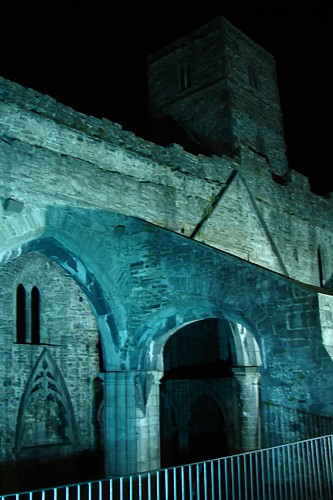
Sligo Abbey, Abbey Street, Sligo with the O'Craian altar tomb
(Photograph: Caoimhghin Ó Croidheáin)
Monuments
The church contains two noteworthy funeral
monuments: the "O'Craian altar tomb" and the mural in remembrance of "Sir Donogh
O'Connor Sligo". O'Craian's tomb is the oldest surviving monument in the church.
Its Latin inscription dates it from 1506 and states that it is the tomb of
Cormac O'Craian (or Crean) and his wife Johanna, daughter of Ennis (or Magennis).
It fills a niche in the northern wall of the nave next to the rood screen. It
consists of a stone table, similar to the altar in the choir, and a canopy
consisting of a high pointed arch with tracery. The style is late Gothic.
"Hic . jacet . Cormacus. Ocraian Et Ehon ac . Nanangasa . uxor. Eis . an . Do.,
MCCCCC VI."
Here lieth Cormac O'Craian, and Nanangasa, his wife, The year of the Lord, 1506.

History
Sligo Abbey, was a Dominican Friary, founded in
1253 by Maurice FitzGerald, 2nd Lord of Offaly, who was Justiciar of Ireland
from 1232 to 1245. His purpose allegedly was to house a community of monks to
pray for the soul of Richard Marshal, 3rd Earl of Pembroke, whom he was rumoured
to have killed. The Dominicans were a poor choice for such a task as their
specialty is preaching rather than praying. FitzGerald built a substantial
Norman abbey, with all the essential parts and endowed it with lands.
https://en.wikipedia.org/wiki/Sligo_Abbey
Founded in 1252 or 1253 for the Dominicans by
Maurice Fitzgerald, 2nd Baron of Offaly, who was also founder of the town.
Having escaped the ravages suffered by the now destroyed Sligo Castle in the
13th and 14th centuries, the Friary was accidentally burned in 1414, but was
rebuilt two years later by Friar Bryan MacDonagh with assistance from (the
other) Pope John XXIII.
In a recess in the north wall of the nave is the O'Crean tomb dated to 1506,
bearing panels in front with the Crucifixion in the centre, the Virgin Mary and
St. John on either side; other figures are probably to be identified as St.
Dominic (in friar's robes), St. Katherine (with remains of a wheel), St. Peter
(with keys), St. Michael (with shield and raised sword), and there are other
unidentified figures.
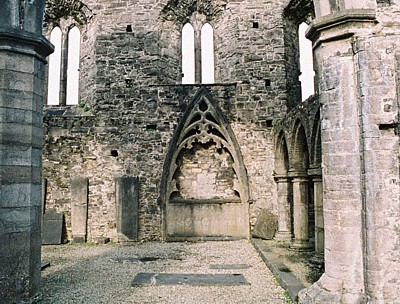
Modern Image of O'Crean Tomb
Sligo Friary, County Sligo.
Copyright Sligo County Library
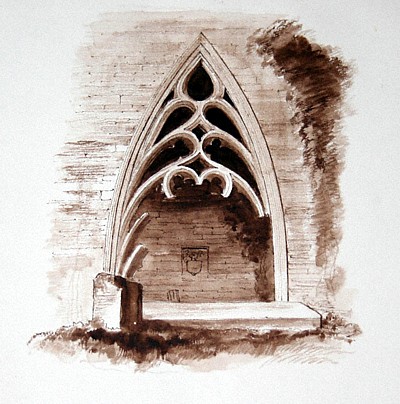
O'Crean Tomb, Sligo Friary
Choir Of Sligo Abbey. Drawn For Colonel Cooper from an
original sketch and partly finished from a photograph July 1882.
Copyright Sligo County Library
Wakeman drew this monument in August 1880. It can be found in a recess in
the north wall of the nave, just west of the rood-screen within Sligo's
Dominican Friary. This is the O'Craian or Crean tomb of 1506 and is the earliest
monument in the church.
What is immediately noticeable is that the lower part of the tomb was completely
buried when Wakeman illustrated it. This is because the Board of Works reduced
the ground level to the original level during the restoration of the friary in
1913 by Doctor Cochrane.
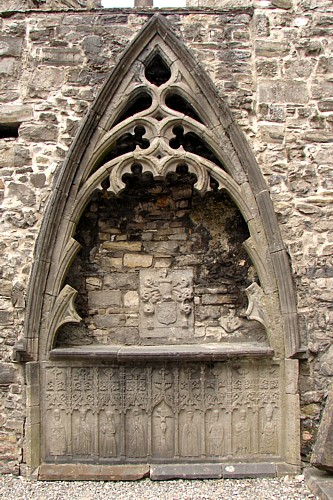
(Photograph: Caoimhghin Ó Croidheáin)
Today, because of the extensive restoration works, the whole tomb can be seen,
while in Wakeman's drawing only the remains of a finely carved canopy and a
later crest of the O'Crean's can be seen.
The tomb chest visible today is somewhat similar in design - called English Late
Gothic - to the high altar but has nine figures carved in relief on arcaded
panels on the front of the tomb.
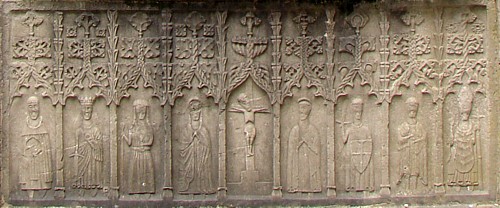
(Photograph: Caoimhghin Ó Croidheáin)
From left to right these comprise a friar, probably St Dominic; then a figure
robed and crowned, with a sword in their right hand and he appears to be holding
a circle against his breast, perhaps representing the wheel of St Catherine; the
third figure is a possible female in a long gown held closed by a belt carrying
a staff with an oval shape on its top, and possibly represents a pilgrim; the
next figure is the Virgin Mary, beside whom is Christ on the Cross, with St John
the Apostle next to him; the next and seventh figure is St Michael the
Archangel, recognisable by his wings, raised sword and shield with a cross on
it; beside him is St Peter the Apostle, holding the keys to Heaven, and finally
there is a bishop holding a processional cross with his hand raised in
benediction.
The Latin inscription along the upper part of the top slab of the tomb chest is
incomplete but the date 1506 (MCCCCCCVI) can be read and the name Cormac
O'Craian. His wife's name might be Johanna Nic Aengusa (Ennis). The O'Crean
family were an important, wealthy merchant family, originally from Donegal but
came to Sligo in the late 15th century.
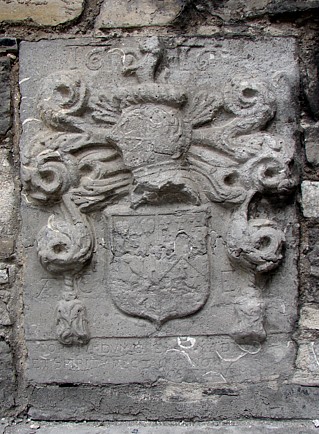
(Photograph: Caoimhghin Ó Croidheáin)
The crest or coat of arms of O'Crean depicted in Wakeman's drawing is an
armorial stone and is the earliest of its type in the Friary, dating to 1616.
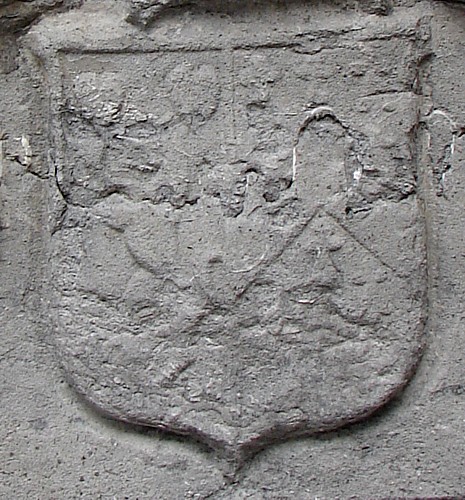
(Photograph: Caoimhghin Ó Croidheáin)
It bears the O'Crean family crest - combined with those of the French family crest. The initials on the crest AC and EF are probably those of Andrew Crean and his wife Elizabeth (?) French.
This monument was erected within the Family
Tomb (altar) in 1616 for Andrew O'Crean and his wife Eleanor French.
While quite deteriorated, you can still identify the following. On top of the
shield is the family crest Demi-wolf with heart in paws. Also the two chalices
(one on either side of the shield) have the initials AC on the left, and EC on
the right. You cannot read the date from the photo, but below the shield it says
1616. Finally, if you study it VERY CAREFULLY, you can make out on the shield,
the two shields of the O'Crean and French families. The French shield is the
lower right under the /\. On the upper left you can make out the top two hearts
of O'Crean. After you see these, you can identify the bottom heart. (Seán F.
O'Crean)
Irish Pedigrees
O'Hart's Irish Pedigrees is a standard work of reference for anyone engaged in Irish genealogy - no library should be without a copy. It was first published in Dublin in 1878 at a time I always thought of as the Celtic Twilight but which Wikipedia tells us was the Irish Literary Revival. This was a time when there was a flowering of work by playwrights, poets and scholars keen to reveal Ireland's Celtic past to an audience who were giving up the Irish language and had forgotten or never knew of Ireland's rich heritage. The work must therefore be seen in that context.
Today a genealogical work which starts with the Creation and giving
a pedigree from Adam and Eve would generally not inspire great
confidence. O'Hart, quoting many ancient texts does exactly that -
stating that the Celtic race descends from Milesius of Spain, his 3
sons and his uncle. The format for the first volume therefore is
divided into 4 sections: Families descended from Heber, Ithe, Ir and
Heremon staring with the families of Brady, Brenan, Carroll, Casey,
Clancy, Coghlan, etc. and ending with Scanlan, Sheane, Spillane,
Sweeny, Tatly, Tierney and Tully. At the end of Vol I O'Hart has
included colour images of Coats of Arms.
The second Vol. gives families who were of Danish, Anglo-Norman,
English, Welsh, Scottish, Huguenot and Palatine extraction. A
General Index of both vols. is to be found at the end of Vol II
together with a most valuable Index of Sirnames (surnames). Also
given is a section Opinions of the Press quoting extracts of
reviews of the book in 78 newspapers and periodicals! One of which,The
Philadelphia Inquirer, said:
.. We have in our midst so many descendants of the old families of
Ireland, that this volume will be deeply interesting and valuable to
those who take pleasure in genealogical researches. Mr. O'Hart has shown
industry, perseverance and zeal in preserving from loss the records of
so many years for the use of our New World.
http://www.archive.org/stream/irishpedigreesor011915ohar#page/n9/mode/2up
Crean Lynch family
It seems that this family is one of the
descendant families of the 17 century Sligo Creans.
Crean
A Blake property at the beginning of the 18th century which passed by marriage
to the Creans, a county Sligo Gaelic family. The Crean family of Hollybrook
House, in the parish of Tagheen, barony of Clanmorris, changed their name to
Crean Lynch following the marriage of Andrew Crean and Mary Lynch, daughter and
heiress of Henry [Dominick] Lynch of Newborough, county Galway. Their grandson,
Andrew Crean Lynch, married Elizabeth Lynch of Clogher, parish of Burriscarra,
barony of Carra. Andrew Crean Lynch purchased the Clogher estate from his
brother-in-law and his descendants lived at Clogher, while Hollybrook was leased
to the Andersons. Patrick Crean Lynch advertised for sale his life interest in
Hollybrook in 1861.
https://landedestates.ie/family/525
Lynch/Crean Lynch
A junior branch of the Lynch Blosse family baronets, who obtained leases of the
Clogher estate, in the parishes of Burriscarra and Drum, barony of Carra, and in
the parish of Tagheen, barony of Clanmorris, county Mayo, for 999 years from Sir
Henry Lynch Blosse 8th Baronet in 1788. Family members had mercantile interests
at Cadiz in Spain. In the 19th century Elizabeth Lynch married Andrew Crean
Lynch of Hollybrook, parish of Tagheen, who bought the Clogher estate from his
brother in law Patrick Lynch. By the 1860s Patrick Crean Lynch was in financial
difficulties and advertised for sale both his Hollybrook and Clogher estates.
Part of the Hollybrook estate was in the parishes of Kilbennan and Kilconla,
barony of Dunmore, county Galway. The Irish Times reported details of the
purchasers of some lots in this sale though other lots were adjourned. In 1870
one of of his daughters, Helena Mary, married James Charles FitzGerald Kenney of
Kilclogher, county Galway. They were the parents of James FitzGerald Kenney,
Cumann na nGaedheal TD for south Mayo 1927-1944 and Minister for Justice
1927-1932. In 1873, another daughter of Patrick Crean Lynch married Anthony
Joseph MacDermott of Ramore, county Galway, and he and other persons sold over
3000 acres in county Mayo to the Congested Districts' Board in March 1913. Over
600 acres belonging to the Crean Lynchs in county Galway was vested in the
Congested Districts' Board on 11 June 1914.
https://landedestates.ie/family/525
Helena Mary Crean-Lynch
Birthabt 1846 - Ballyglass, Co. Mayo, Ireland
Death26 May 1903 - Clogher House, Ballyglass, Co. Mayo, Ireland
MotherMarcella Mary Bellew
FatherPatrick Crean-Lynch
Born in Ballyglass, Co. Mayo, Ireland on abt 1846 to Patrick Crean-Lynch and
Marcella Mary Bellew. Helena Mary Crean-Lynch married James Christopher
Fitzgerald-Kenney and had 3 children. She passed away on 26 May 1903 in Clogher
House, Ballyglass, Co. Mayo, Ireland.
Helena Mary Crean-Lynch family treeFamily tree
Explore more family trees
Parents
Patrick Crean-lynch
1813 - 1881
Marcella Mary Bellew
1825 - 1867
Spouse(s)
James Christopher Fitzgerald-kenney
Unknown - 1877
Children Show all
William Lionel Fitzgerald - Kenney
1872 - 1956
Helena Julia Olivia Anna De Kenne Fitzgerald-kenney
1875 - Unknown
https://www.ancestry.com/.../helena-mary-crean-lynch-24...
George Crean Lynch
Birth1848 - Galway, Ireland
Death9 Apr 1939 - Dublin, Ireland
MotherUnavailable
FatherOther Crean Lynch
Born in Galway, Ireland on 1848 to Other Crean Lynch. George Crean Lynch had 8
children. He passed away on 9 Apr 1939 in Dublin, Ireland.
George Crean Lynch family treeFamily tree
Explore more family trees
Parents
Other Crean Lynch
Unknown - Unknown
Unavailable
Children Show all
Andrew Crean Lynch
1874 - 1955
Francis Crean Lynch
1884 - 1958
https://www.ancestry.com/.../george-crean-lynch-24-lctsn8
Hollybrook
Estate(s)
Lynch/Crean Lynch
Crean
Townland Boleybeg
Civil Parish Tagheen
PLU Claremorris
DED Tagheen 93
County Mayo
Barony Clanmorris
Description In 1786, Wilson refers to Boullybeg as the seat of Mr. Crean. This
house was the home of the Creans and Crean Lynches. At the time of Griffith's
Valuation the house was occupied by Ephraim and George Anderson, leasing from
Patrick C. Lynch, when it was valued at £25. It is now a ruin.
https://landedestates.ie/property/341
Ballinvilla
Estate(s)
Crean
Townland Ballinvilla Demesne
Civil Parish Bekan
PLU Claremorris
DED Culnacleha 78
County Mayo
Barony Costello
Description The home of the Crean family in the 19th century. Ballinvilla was
held in fee by Austin F. Crean at the time of Griffith's Valuation when it was
valued at £7. This house no longer exists.
https://landedestates.ie/property/99
Crean
A family transplanted to county Mayo from county Galway under the Cromwellian
settlement. The Crean family first settled at Brickens, in the parish of Bekan,
barony of Costello, county Mayo. By the mid 19th century they held five
townlands in the parish and were residing at Ballinvilla. In 1876 Arthur Lynch
Crean had an estate of 731 acres. By March 1916 Austin F. Crean had accepted an
offer from the Congested Districts' Board for the purchase of 571 acres of his
estate.
Associated Families
Crean
Houses
Name Townland Civil Parish PLU DED Barony County Map Ref
Ballinvilla Ballinvilla Demesne Bekan Claremorris Culnacleha 78 Costello Mayo
OSI Ref: M422 742
OS Sheet: 102
Discovery map: 39
https://landedestates.ie/estate/119
Rookwood
Estate(s)
Ormsby (Tobervaddy)
Kelly (Rookwood)
Thewles
Bayley (Rookwood)
Waller (Rookwood)
Townland Rookwood or Bellagad
Civil Parish Athleague
PLU Mountbellew
DED Killeroran 149
County Galway
Barony Killian
Description The house, located on the border between counties Galway and
Roscommon, was built in the late 1720s by a branch of the Ormsby family of
Tobervaddy. Jane Ormsby married Robert Waller. Both Wilson and Taylor and
Skinner record that Rookwood was occupied by Major Waller in the 1780s. The
house was later leased by the Thewles family. Edmund Kelly purchased the lease
of Rookwood from his cousin, James Thewles, in 1800. The house was occupied by
the Taaffes in the early 19th century and by the Kellys from the 1830s. In 1900
Dr Charles E. Crean of Ballyhaunis bought Rookwood and sold it to the Land
Commission in 1922. The house was intermittently occupied until the 1940s and
gradually became derelict.
https://landedestates.ie/property/1033
Pic below:
Hollybrook House, Boullybeg townland
In 1786, Wilson refers to Boullybeg as the seat of Mr. Crean. This house was the
home of the Creans and Crean Lynches.
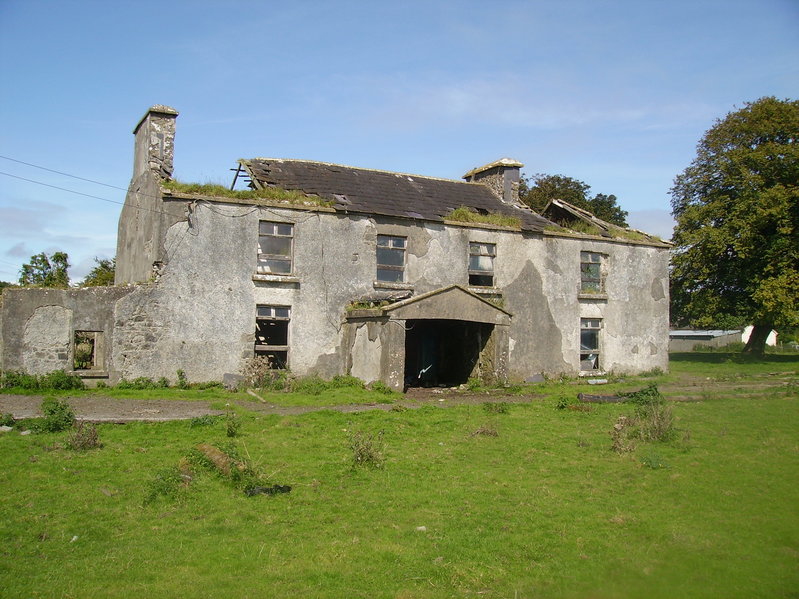
Census of the Diocese of Elphin 1749
(Cryan/Crean)
Here is the Cryan/Crean results of the Census of the Diocese of Elphin 1749 from
findmypast. (There are crossovers). There are Crean and variants in Roscommon
and Cryan variants in Sligo. But the Cryan variants are mainly in Roscommon. So
while Crean has a long history in Sligo, Cryan seems to be relatively new. So is
it possible that as the Creans declined in importance in Sligo in the 17th
century, they moved to other counties where the local accent pronounced Crean
differently? If so, then it is very likely that the Cryans are descendants of
the Sligo Creans.
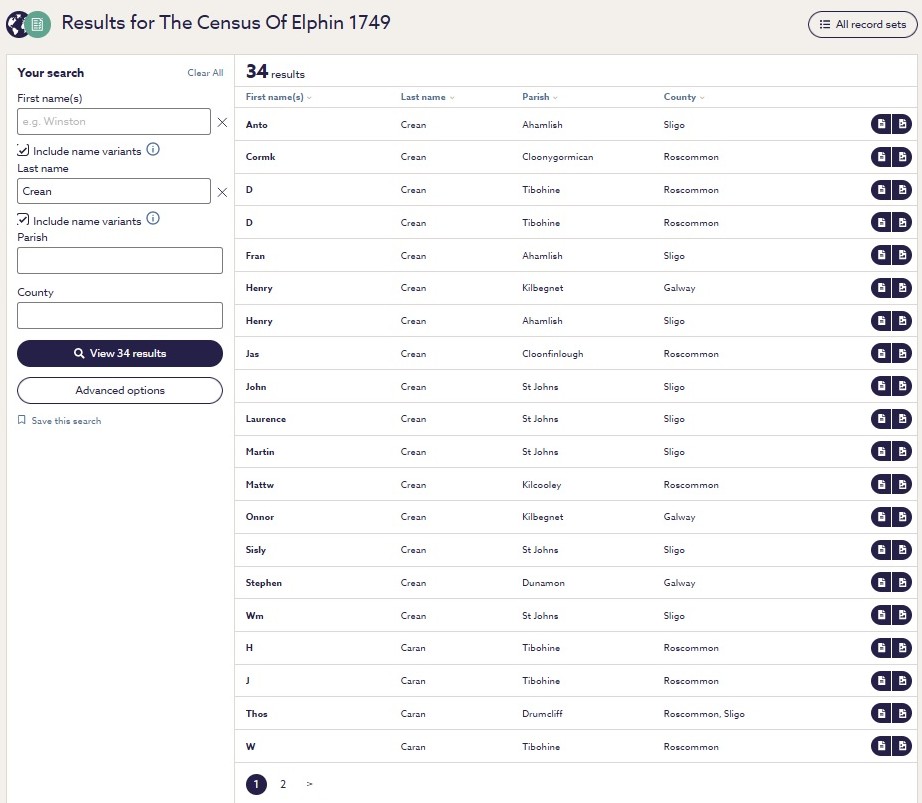
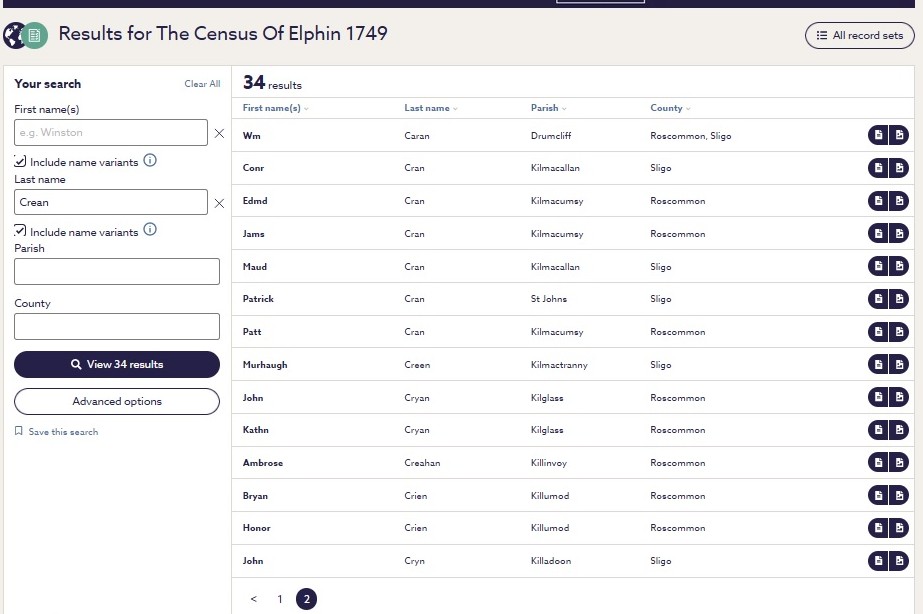
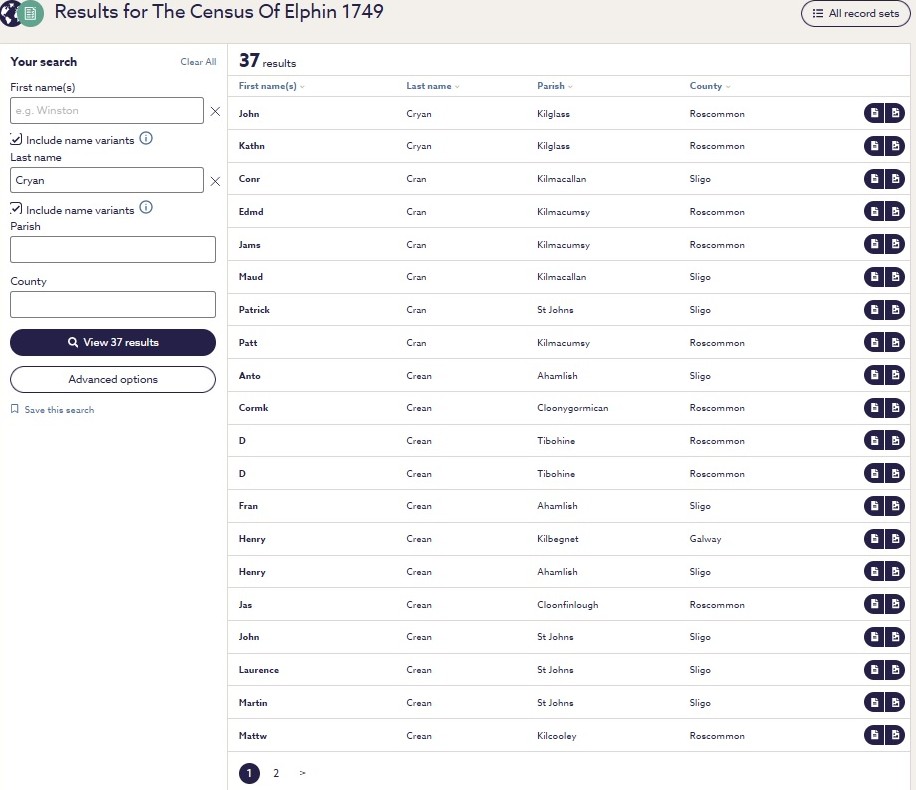
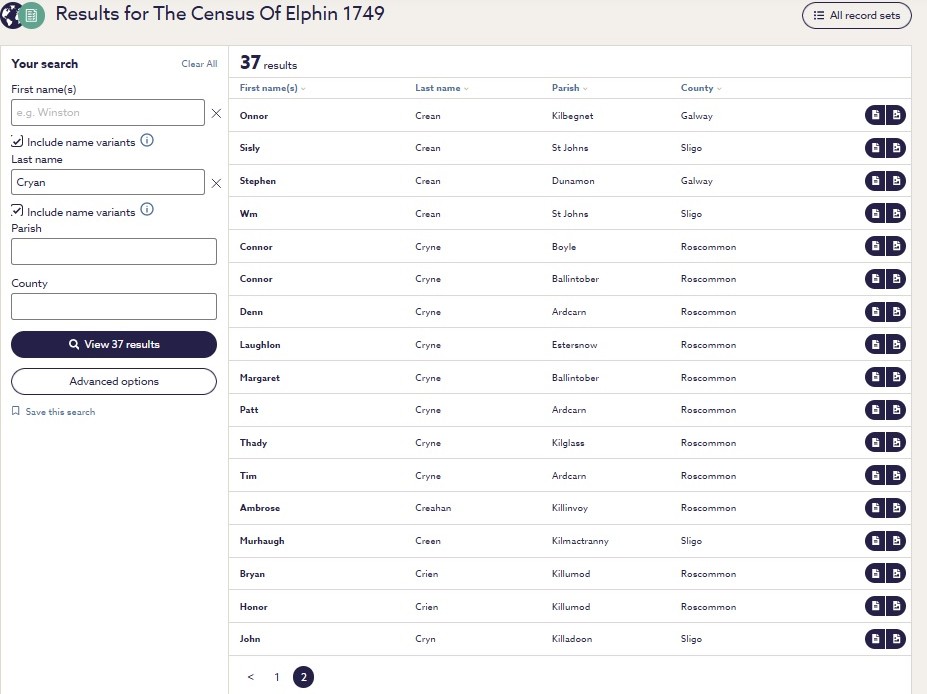
Carrowreagh Cryans
Patricia Buker
Currently, there are 3 Cryan families in Carrowreagh (that we know of) and they are all related to Sean Rua Cryan, approx 4 generations back. From what I understand, my Gr.Gr.Grandfather Sean Rua (Red John) had 8 daughters and 5 sons. Two of the sons died young and the farm was split between the remaining 3 sons, Patrick (Padraig Rua), Martin & Peter Cryan. The property on which the family house was located was left to Padraig Rua who is my direct ancestor.
Sean Rua married a woman with the maiden name Carney. I believe that there were 8 daughters & 5 sons. The birth dates are not known at this time
-
Michael, died May 7, 1907 (26yrs). An obituary for his funeral is available
-
John...believed to have died young
-
Peter
-
Martin
-
Patrick (also called Padraig Rua) was my Great Grandfather
-
Nora (married name Kehoe)
-
Winifred (married name Cummins or Mr.G.Commons, Mrs.L.Commons)
-
xxxx (married name Nolan, Mr.& Mrs.J.J.Nolan)
-
xxxx (married name Fitzmorris or Mr.& Mrs.P.Morris)
-
xxxx (married name Kallery)
-
xxxx (married name Connor or Mrs.G.O’Connor)
-
xxxx (married name Mr.& Mrs.M.Connellan)
-
Frances ?
Sources
-
in black text, my Grandmother Delia Cryan communicated the history in 1980.
-
In blue text, an obituary from 1907 names sisters and brother-in-laws. Using this as a reference, there appear to be alternate surnames. For this reason, I’ve included both for cross-reference purposes.
-
Also, the obituary from 1907 also references uncles which suggested that Sean Rua had a brother Luke Cryan. The same obituary suggests that his Sean Rua’s wife had brothers Peter Carney, John Carney & Martin Carney.
My Gr.Grandfather was Padraig Rua Cryan (Red Patrick Cryan). He married
Catherine O’Reily and had 5 sons and 2 daughters. The birth dates are not known at this time
-
Mai > Birthdate unknown. Died Oct.10/81. She married Charlie Barrett and remained in Co.Leitrim, Ireland
-
Ann (called Nell) > married name Kenny
-
Tom > died when he was 7 at the family home in Carrowreagh. The description from my grandmother suggested Meningitis.
-
Padraig
-
Samual Gerard > born 1902. Immigrated to Argentina
-
William > was killed by a car in New York
-
John Joseph > my Grandfather, raised his family in Carrowreagh, Ireland.
My Grandfather was John Joseph Cryan (called Jack) Cryan. He married
Bridget Agnes (called Delia, maiden name Elwood). They had 5 sons.
-
Padraig, b1926, married Patricia O'Connor in Carrick-on-Shannon
-
Joseph, b1927, immigrated to Canada, 1949, Married Mary (Kelly) & died Sept.30, 2007
-
Richard, b1930?, resides in Carrowreagh
-
Samual, b1932?, resides in Carrowreagh
-
Thomas, b1934. He immigrated to Toronto, Canada in 1953, married Jessie Briget (called Netta, maiden name Kelly) Aug. 31, 1957. They had 6 children which includes me (Patricia. My mother was born in Glasgow, Scotland on Dec.17, 1935 and lived in Mallaig, Scotland until 18 years old. They had 6 children.
-
Delia Margaret b1958 in Toronto, Canada. Married Charles Grech & had 3 children, Christina Maria, Melissa Carmela & Rebecca Anne.
Patricia Mairi b1959 in Toronto, Canada. Married Kerry Buker Oct.10, 1981 and had 3 children, Brendan Patrick b1984, Shawna Mairi b1986 & Kylie Margaret b1988. -
John Michael (called Iain) b1960 in Co.Roscommon, Ireland. He died Feb.21,2000. Never married.
-
Gerard Patrick b1961 in Co.Roscommon, Ireland. Married Lorrie (maiden name Tremaine) and had 2 children, Kevin & Colleen
-
Thomas James b1964 in Toronto, Canada. Married Sharon (maiden name xxxxx, 1st married name McQuade) already had 2 children Ashleigh & Angeleigh. Tom & Sharon had 2 more children, Connor & Sinead.
-
Maureen Anne b1976 in Toronto, Canada. Married Patrick Farrell and had 3 children, Peri Jane, Caeden James & Layne Rian.
Robert Cryan (1827-1881)
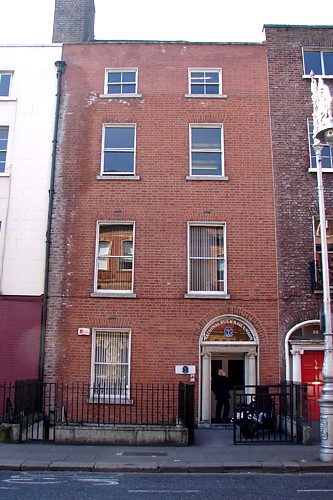
54 Parnell Square, Dublin
(Photograph:
Caoimhghin Ó Croidheáin)
Robert Cryan (1827-1881) was an Irish medical doctor, professor of Anatomy and
Physiology at the Catholic University in Dublin, Ireland, as well as a lecturer
on anatomy and Physiology at the Carmichael School of Medicine in Dublin.
Grave of Dr Robert Cryan and
other members of the family
Dr Robert Cryan's family tree

Robert Cryan lived at 54 Rutland Square, (now called Parnell Square, Dublin,
Ireland, and was licensed to practice medicine in 1847 by the Royal College of
Surgeons.
See:
http://en.wikipedia.org/wiki/Robert_Cryan
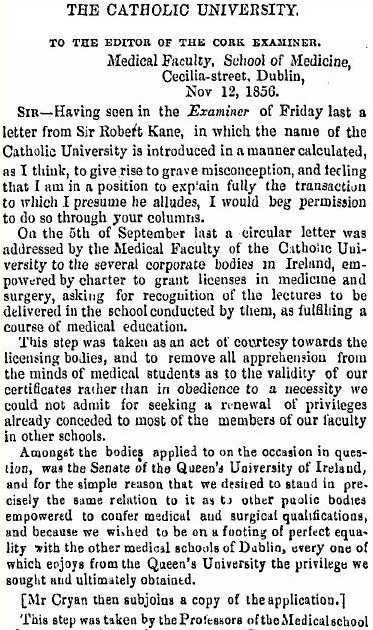
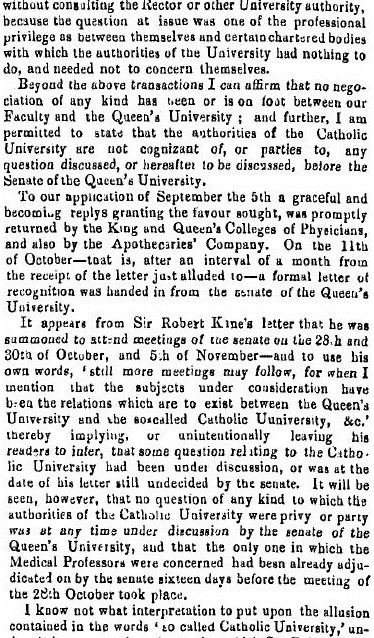
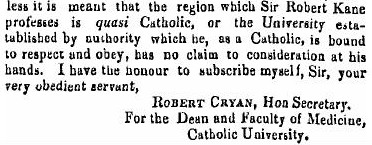
The Nation 22 November 1856
My Cryan Genealogy
My great great grandfather, John Cryan, married Margaret Dolan in Boyle, Co.
Roscommon in 1858 and spent his life in Croghan, about 5 miles south of Boyle,
working as a National School teacher (where he is still remembered as Master
Cryan) until his death in 1906. From his age on his Death Certificate I believe
he was born around 1833 and a reference to a family who had a son, John, at that
time has been found. This was a couple, John Cryan and Catherine Drury, who
married in 1829 in Croghan and had three sons John (b.1833 in Boyle), James
(b.1842 in Boyle) and Patrick (b.1831 in Croghan). I do not know what happened
to Patrick and James. Does this information sound familiar to you? Have you ever
heard talk of a Master Cryan in your family? Maybe these names have been passed
down through the generations as they have in my family. Please let me know at
caoimhghin@yahoo.com
THE FAMILY OF JOHN CRYAN
John and Margaret (Dolan) married in 1858 in
Boyle, Co. Roscommon and then lived and worked in Croghan (townland-Killapogue;
parish-Killommod) living in a house with stone walls and a slate roof and four
rooms - a good house for its time considering most people lived in a two-roomed
thatched cottage. The house was rented from the local big landlord Guy Lloyd
(DL).
Croghan National School, where John worked, was small having one school room (27
ft. by 12ft.). He taught an average daily attendance of 43 boys and 20 females
although there was officially a lot more on the roll. John started getting paid
on the 18th. August 1856 and received 3 pounds and 10 shillings per quarter
year. By the 23rd. of February 1861 Margaret Cryan, then aged 23, had applied to
the Commissioners of Education to be paid for her work as a Work Mistress which
she had started unpaid on 7th. January 1861. She taught Dressmaking, Shirt
Making, Plain Sewing, Knitting and Cutting-Out and was described as "very
competent, good character" by the Inspector of National Schools - "I recommend
that the aid sought for be granted, the number of girls attending being
considerable and the individual instruction being of great importance to them
and calculated to promote their regular attendance". Date of visit 16th. April
1861 and it was recommended she be paid 8 pounds per year.
In the 1880s a bigger school was built.
Old schoolhouse, Croghan Co Roscommon
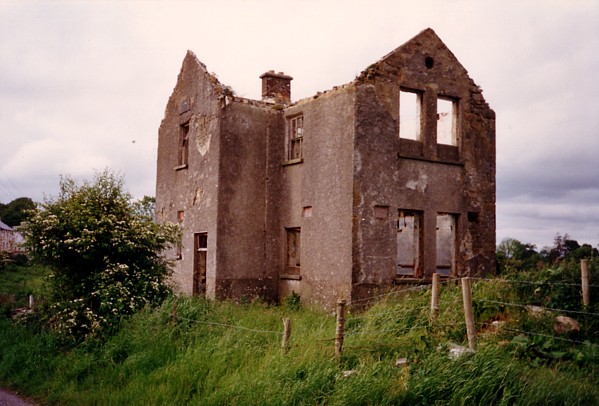
My
great great grandfather
John Cryan (1830s-1905) taught here.
Demolished 1990s
(Photograph: Caoimhghin Ó Croidheáin)
They had 9 children and all were born in Croghan.
By the 1901 Census, John had retired and was still living in Croghan. He died
there on 27th. November 1905 having written his Will three years earlier in 1902
-
I, the
said John Cryan, being of sound mind do solemnly bequeath this 12th. day of July
1902, to my wife Margaret Cryan of the above mentioned place the policy of
Assurance of £100 (one hundred) with Profit in the Patriotic Assurance Coy. 9
College Green, Dublin, contracted on the 7th. day of June 1892, also four shares
of one pound each in Croghan Co-Op Agric. Dairy Society Ltd. together with my
household effects, to be disposed by her in whatever manner she considers best.
Given this 12th. day of July 1902 from under my hand. Signed - John Cryan.
John died on the 27th of November 1905 of an Apoplexy (one year cert) in the
townland of Killappogue, Croghan aged 70 years and the death was witnessed by
Patrick Beirne.
After Johns' death Margaret moved to Carrick-on-Shannon, Co. Leitrim, where she
was present for the 1911 Census. She lived with her daughter Maggie in the
parish of Killtoghert. They had a fairly big house being of brick or stone, a
slate roof, five or six rooms and four windows in the front of the house. Her
next door neighbour was a Mary A. Dolan, possibly a relative and the reason why
she moved to Killtoghert.
They had nine children -
Mary Jane (b.1859, bap.9th.Oct, d.1902)
Mary Jane also became a national teacher. She
applied at the age of 16 to be a teacher in Croghan National School. She had
been appointed a 2nd. Class Monitress on 1st. April 1873 and acted the part of
Assistant since April 1876. She was described by the inspector as "competent,
good character" and was granted £25 per year. The inspector made the following
report - "I recommend that the application be granted, the attendance for the
year was 84. The Work Mistress will resign if the salary be granted to this
teacher who is her daughter". Signed R.C. Mc Kell, District Inspector of
National Schools, 24th. January 1877. Mary Jane died of Influenza (2 months
certified); Phthisis (2 years certified) on 13th. March 1902 aged 43 years and
had never married. Her sister Maggie Ann witnessed and registered the death on
7th. May 1902 in Croghan.
John (b.1861, bap.15th.Nov)
John must have died at birth as a second son
was also called John (Johnnie).
Joseph [My great grandfather]
(b.9th.Feb.1864, bap.15th.Nov. d.1932)
Joseph joined the Royal Irish Constabulary at
the age of 18. He moved away from home and worked around the country. He married
Johanna Shanahan from Valentia Island in Co. Kerry in 1890 and they had nine
children William John [my grandfather] , Stephen, Mary Elizabeth, Margaret,
Catherine, John Joseph, Annie, Patrick, and Joseph.
James (b.1866, bap.19th.May)
The R.I.C. Records record a James Cryan born
in Co. Roscommon, aged 21 when appointed on 7th. June 1887, (height 5'8'') and
sent to Kerry for temporary duty and pensioned on 1st. March 1906. The age and
county fit perfectly, so if this is the same James Cryan he would apparently
never have married.
Catherine (Kate) (b.1868, bap.8th.Aug.)
Although it states on the 1901 Census in
Croghan that she was 25 years and living at home, she was actually 33 years old.
It is possible that she married though I have not as yet found a Marriage
Certificate which is made more difficult by the fact that she would thereafter
gone by husbands name.
Stephen (b.1870, bap.27th. d.1892)
Stephen died of Cardiac disease (1 year
cert.) in 1892 at the age of 21. His brother Johnnie was present at the death on
23rd. January and registered it on 14th. March 1892. Stephen died a bachelor.
Margaret Ann (Maggie A.) (b.1874,
bap.17th.March d.1911)
Maggie A. was present for the 1901 Census in
Croghan where she lived at home. After her fathers death she moved to
Carrick-on-Shannon with her mother, now elderly , and was present for the 1911
Census there. She died a spinster on 17th. April 1911 of Peritonitis (7 years
Cert.) aged 37. The death was witnessed and registered by Brigid J. Cryan, her
sister, on 24th. April 1911.
John (Johnnie) (b.1876, bap.15th.June. d.1907)
Johnnie was present for the 1901 Census where
he was living at home. He died at the age of 26 on 17th. January 1907 of
Phthisis (2 years Cert.), a bachelor, and the death was witnessed and registered
by Maggie A. on 7th. May 1902.
Brigid J. (b.1882, bap.10th.Aug. d.1933)
Brigid was present at home for the 1901
Census where she is described as a "Scholar" i.e. attending school. According to
Teda Cryan, Brigid became a teacher in Athlone and met two of her nephews who
were stationed at the Army Barracks nearby. She died on the 2nd September 1933,
a spinster, at Summerhill Convent, Athlone aged 45 years of Amicular Fibrelahan
(3 months cert.) and Syncope (quarter hour cert) witnessed by Rosanna Murray an
occupier of Summerhill Convent, according to her death certificate.
Croghan Village Circa 1900
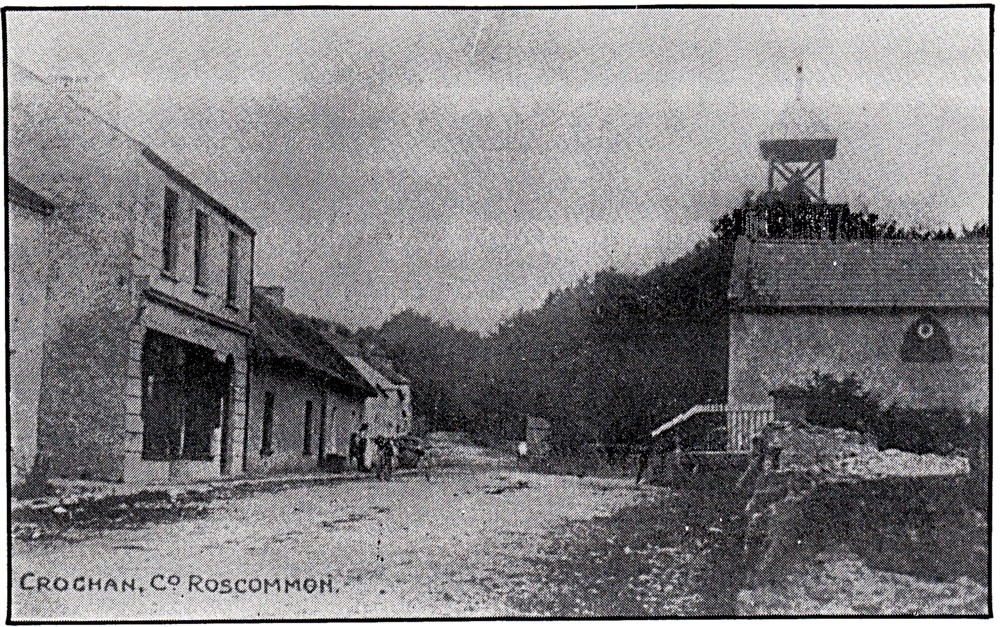
Map of Parish of Croghan
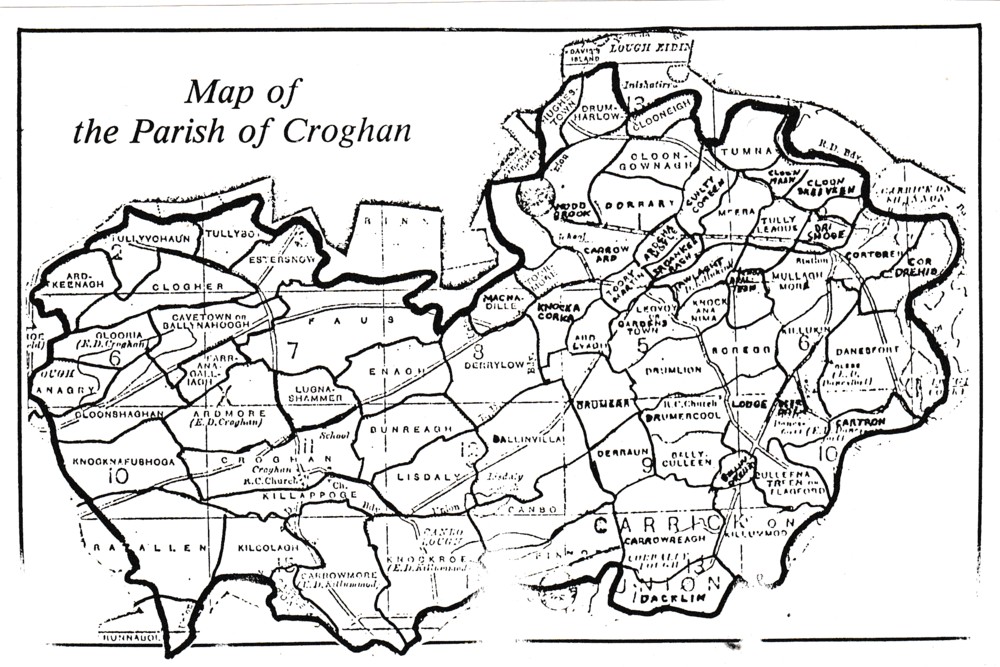
From A Topographical Dictionary of Ireland, 1837
by Samuel Lewis
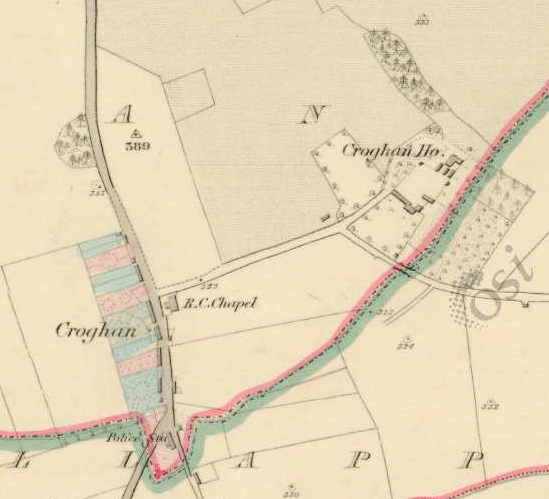
My Great Great Grandmother Eliza Shanahan
(Valentia Island, Co Kerry)
Her daughter Johanna married my great grandfather Joseph Cryan
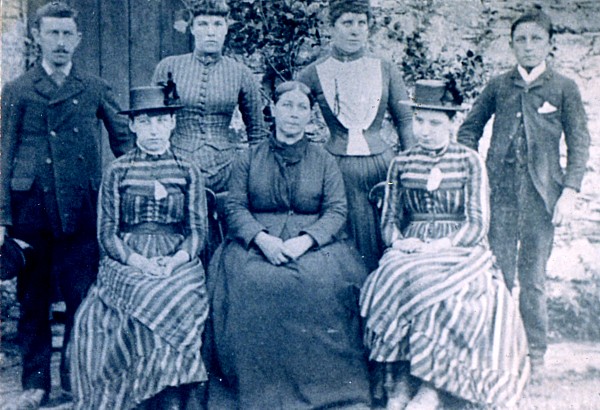
My Great Great Grandmother Eliza Shanahan (nee Sullivan, centre, front row) and her family,
Valentia Island, Co Kerry c1890s
Standing - Pat/ Annie/ Johanna / Mick.
Sitting - Maria/ Eliza (Their mother, nee Sullivan) / Nell
My Great Grandaunt, Bridget Cryan (b 1882)
(first from left)
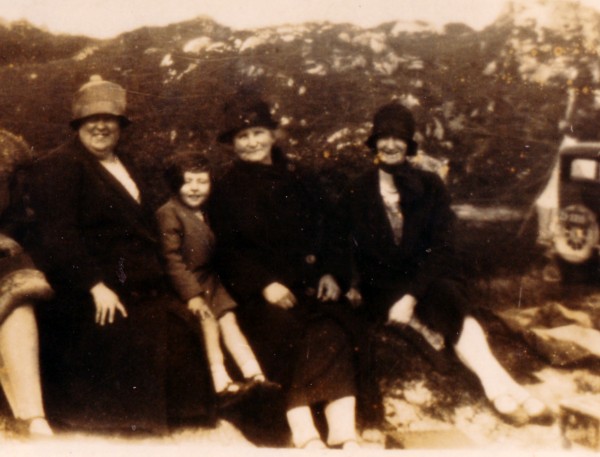
My Great Grandaunt, My Father's First Cousin,
My Father's Paternal Grandmother, and My Grandaunt c1920s
Bridget Cryan (b 1882) / Joan O Neil / Johanna Cryan (Shanahan) / Girlie (Cryan)
O Neill.
My paternal grandmother Sarah Cryan
(Kelly) with her mother Jane Kelly (Carty) out for a stroll c1930s
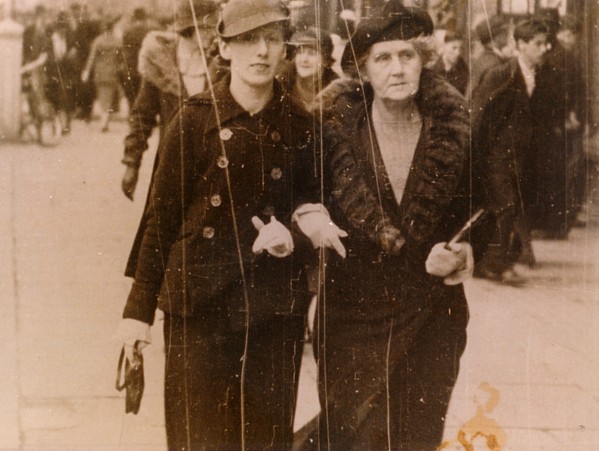
Sarah (Kelly) Cryan / Jane( Carty) Kelly (Sarah’s mother).
1930s
My grandparents Liam and Sarah (Kelly) Cryan 1930
|
|
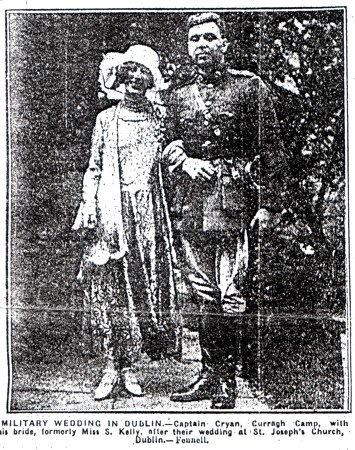
|
Liam and Sarah Cryan
on their wedding day July 1930 in Dublin
and in Saturday Herald.
They had four children:
Des Cryan, Kevin Cryan (my father), Lauri Cryan, and Sally Cryan.
My grand uncle Stephen Cryan (1892-1963) 1920s
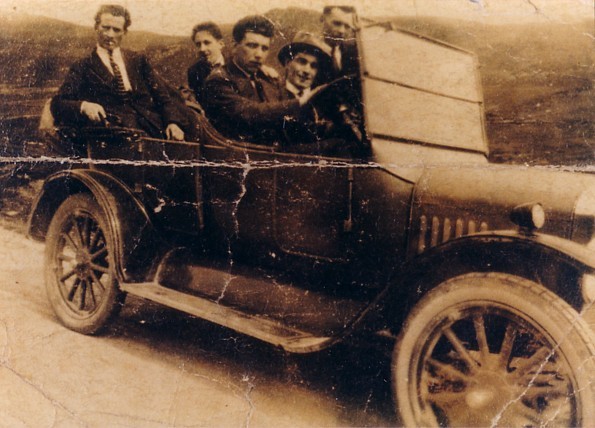
Stephen Cryan, at the wheel (Kerry
No.3 Brigade I.R.A)
Driving a Ford Model T Touring c1920s
My grand uncle Joseph Cryan with his wife Olive
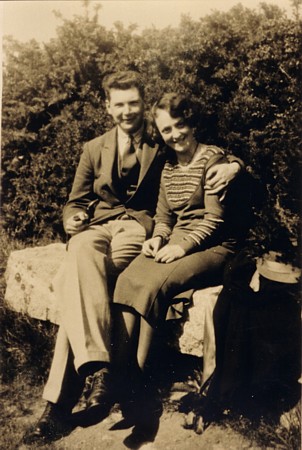
Joseph Cryan / Olive (Foster) Cryan 1930s
My grandfathers brothers and brother-in-law 1920s
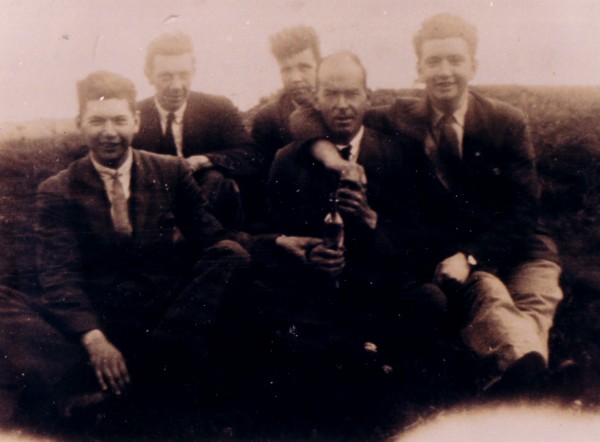
My grand uncle Pat Cryan, Garda H.Q. in the Phoenix Park
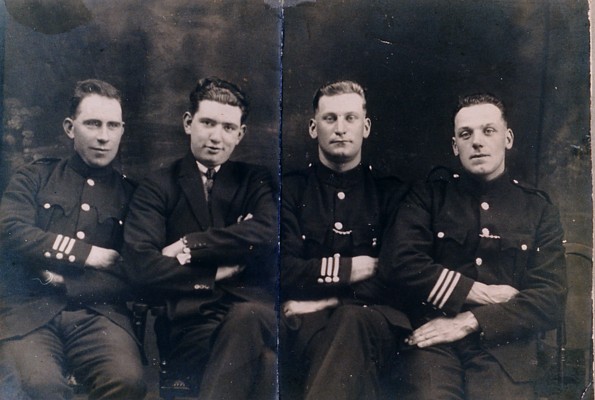
Unknown / Pat Cryan (1905-1982) / Unknown / Unknown / 1920s
My father (Kevin Cryan) and siblings 1950s
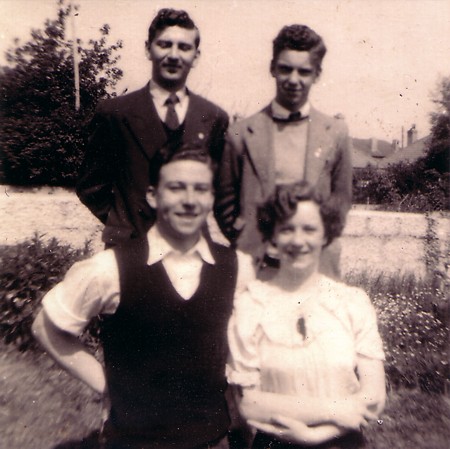
Back row Des Cryan / Kevin Cryan/
Front row Lauri Cryan / Sally Cryan 1950s
‘Genetic Homelands’
http://www.irishorigenes.com/
Not had a DNA test? Then click on the Family Tree DNA
http://www.familytreedna.com/default.aspx
Surname distribution map for Cryan:
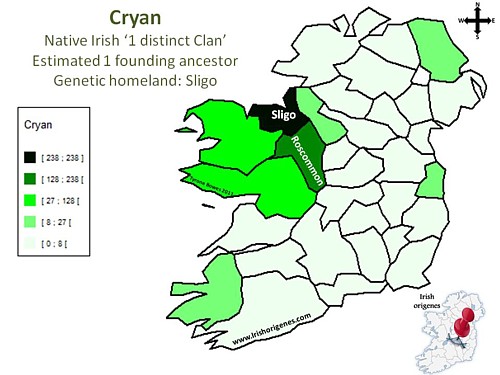
Surname distribution map for Crean:
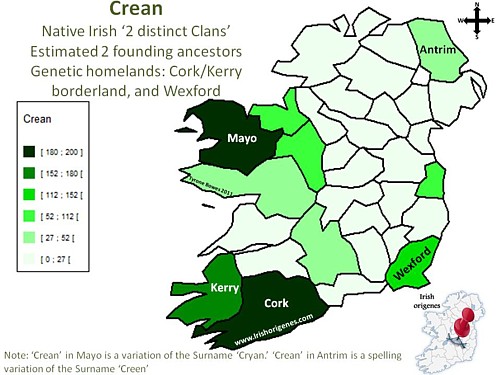
Surname distribution map for Crehan:
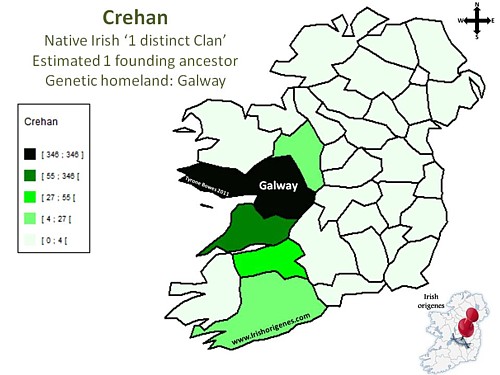
Cryan Opticians
105, Lower George's Street, Dún Laoghaire, Co. Dublin
http://dublin.ratemyarea.com/places/cryan-opticians-5822
John Cryan
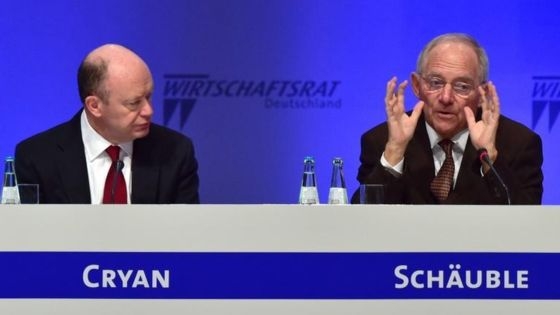
There are two people standing in the way of Deutsche Bank and panic. The first is the current chief executive John Cryan. He is no swashbuckling Fred Goodwin (RBS) or Bob Diamond (Barclays) of pre-crisis notoriety. He is a very conservative, feet on the ground pragmatist. He's already managed to reduce the debt of the bank and has plans to do more. The other is even more important. German Finance Minister Wolfgang Schaeuble. He has said this year that he considers Deutsche Bank "rock solid". That is not only reassuring in itself, but indicates there is no way on earth that a rich German government would let the most important bank in Germany - and by extension Europe - come to any harm.
http://www.bbc.com/news/business-36723034
Cash won't be around in a decade, the chief executive of one of Europe's biggest banks predicted on Wednesday. "“Cash I think in ten years time probably won’t (exist). There is no need for it, it is terribly inefficient and expensive,” John Cryan, chief executive of Deutsche Bank, said during a discussion on financial technology, known as "fintech".
http://www.reuters.com/article/us-davos-meeting-banks-technology-idUSKCN0UY259
A fellow Cryan predicting the end of cash. They have to end cash before they can bail in so there will be no run on the banks...
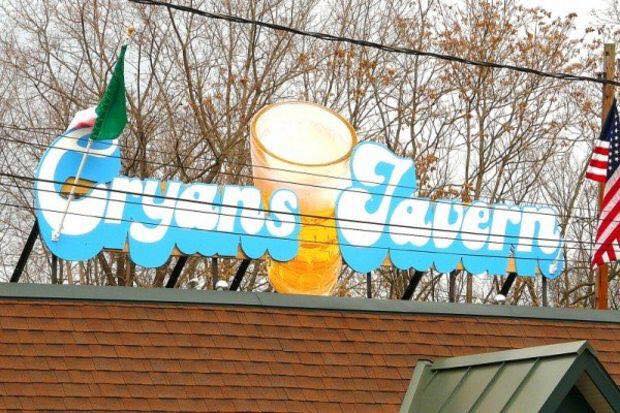
Cryan's Tavern, Hunterdon County, NJ, USA
"If you're ever in Hunterdon County, NJ, USA stop in for Pint and say Hi to
the Cryan Family.
Our family roots are from Castlerea, County Roscommon"
Dan Cryan
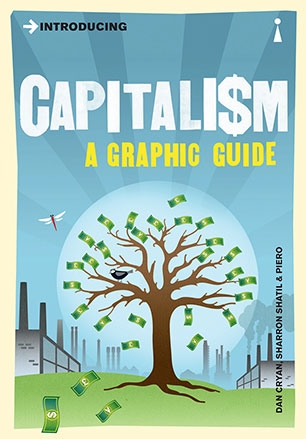
John Cryan
University College Cork
John Cryan, a neuropharmacologist and microbiome expert from the University
College Cork, shares surprising facts and insights about how our thoughts
and emotions are connected to our guts.
Cryan's Teach Ceoil,
Carrick-on-Shannon, Ireland
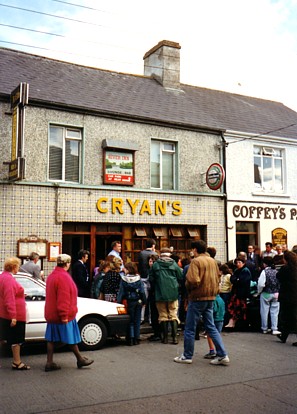
Bridge Street, Carrick on Shannon, Ireland (1990s)
(Photo: Caoimhghin Ó Croidheáin (Kevin Cryan))
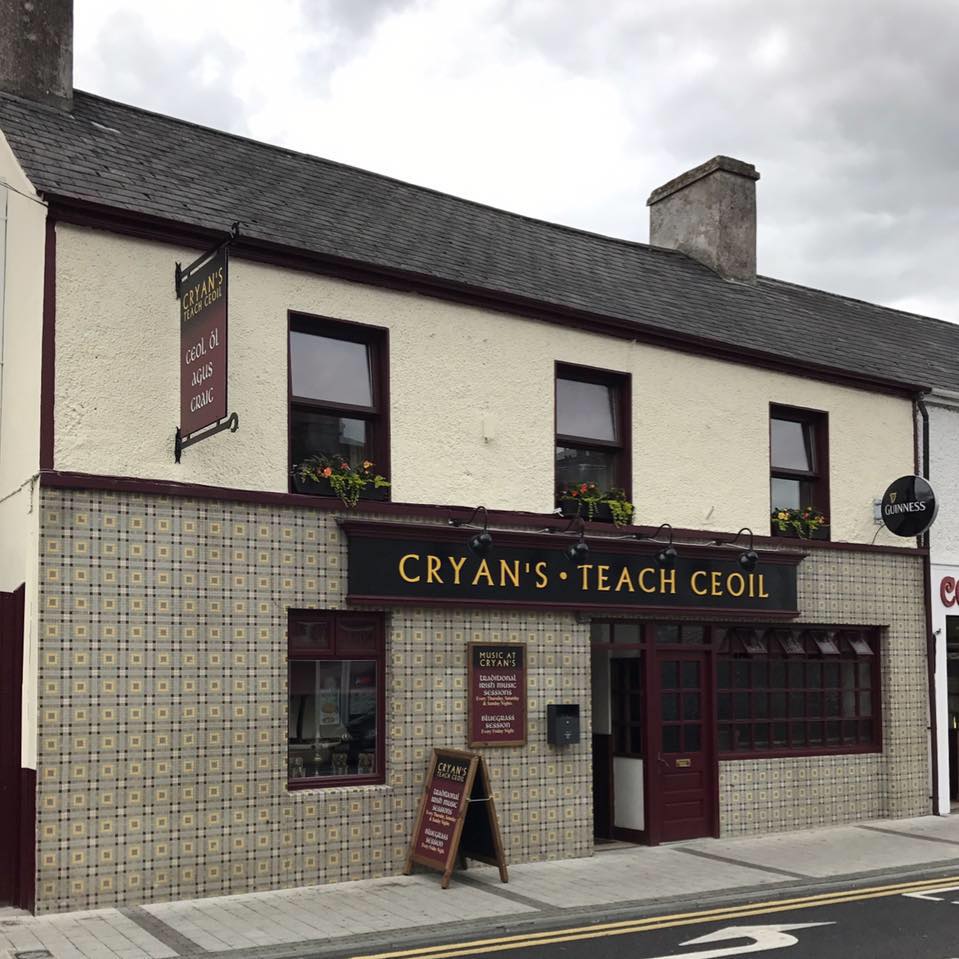
Bridge Street, Carrick on Shannon, Ireland, today
https://www.facebook.com/cryansteachceoil/
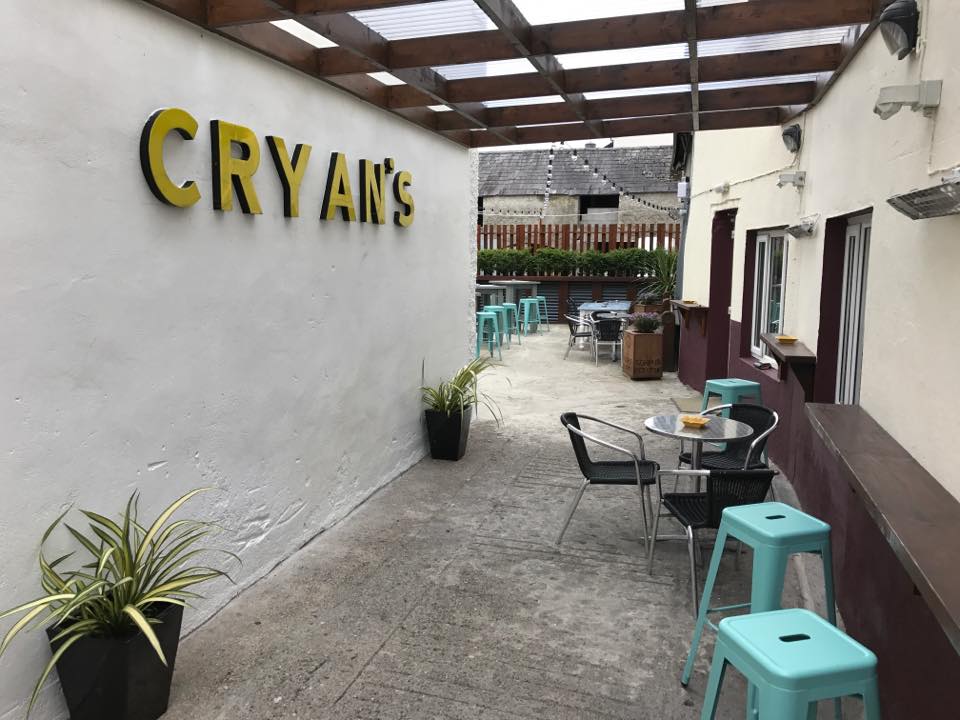
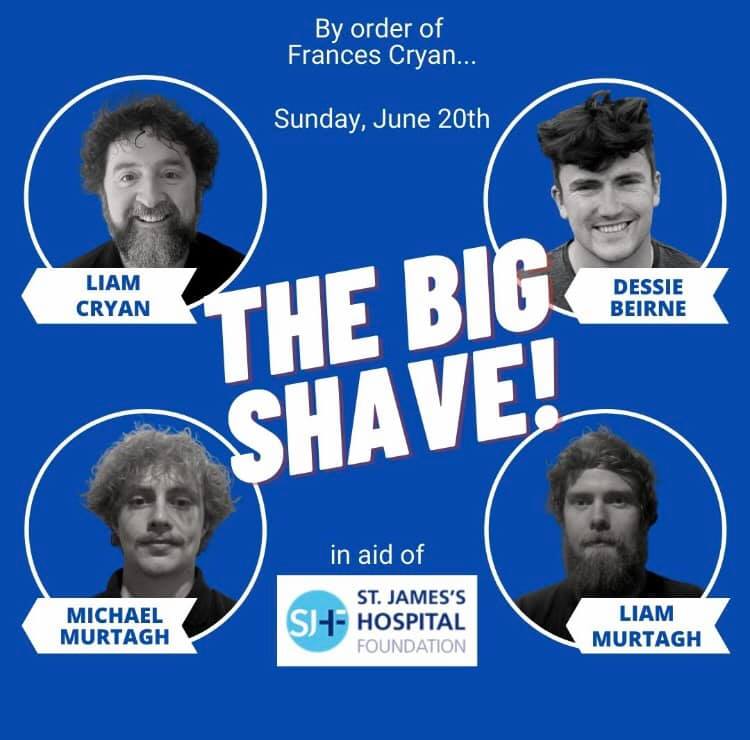
Crean's pub,
Oldcastle, Co. Meath
(Sligo Creans)
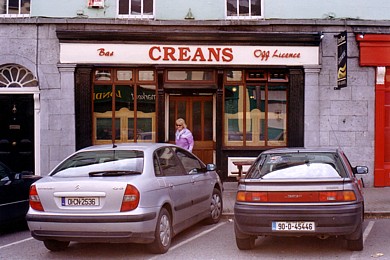
Crean's Shop, Townsend Street, Dublin
Civil War Memorial - John Creane / Seán Ó Croidheáin
(Not sure if these were North Creans (Sligo- Ó Croidheáin)
or South Creans (Kerry - Ó Cuirin?)
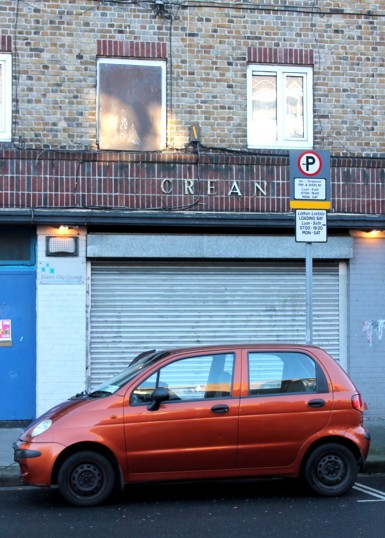



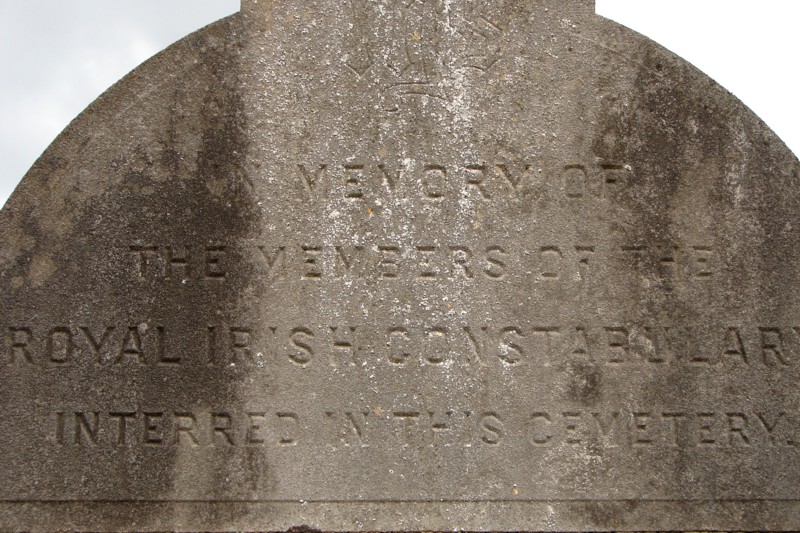
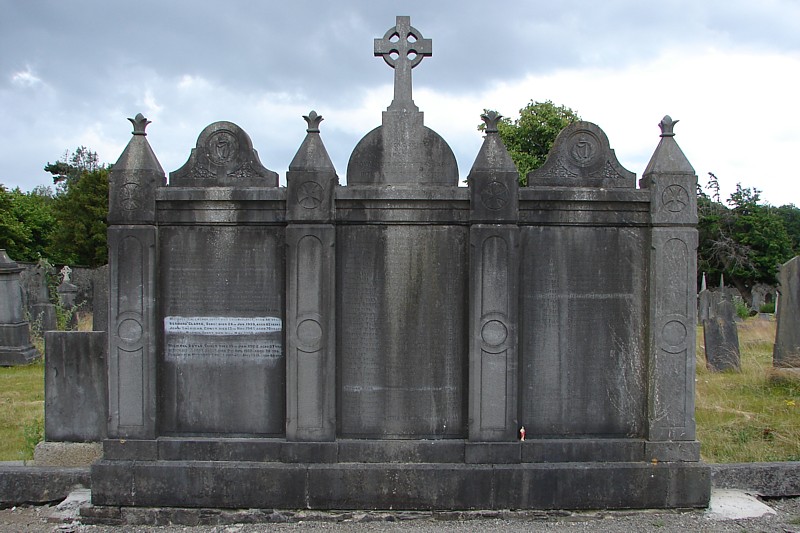
Glasnevin Cemetery, Dublin 2010
Inventory
of Irish War Memorials.
http://www.irishwarmemorials.ie/
Surname, Forenames
War
Regiment / Service
Site
Memorial
Cryan, John
WW I
Lancers (all regiments) Lancers(5)
Castlebar, Mayo Peace Park
Mayo Great War Memorial
Cryan, Patrick
WW I
Irish Guards
Dublin 07, Broadstone Station
Midland and Great Western Railway Memorial
Surname, Forenames
War
Regiment / Service
Site
Memorial
Crehan, J.
WW I
Leinster Regt.
Portlaoise
4th Leinster Regiment Great War Memorial
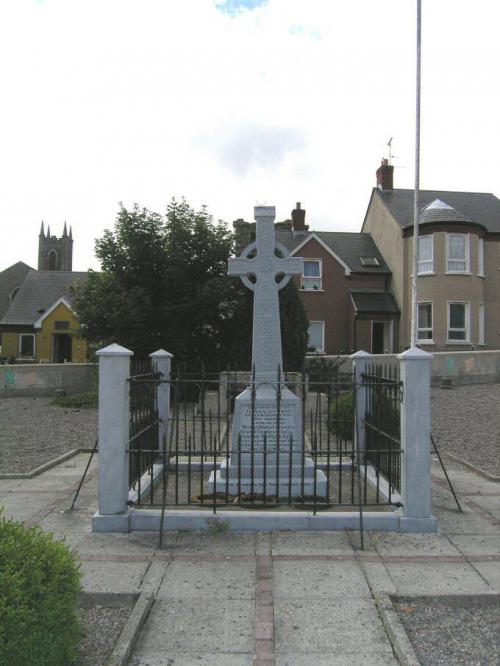
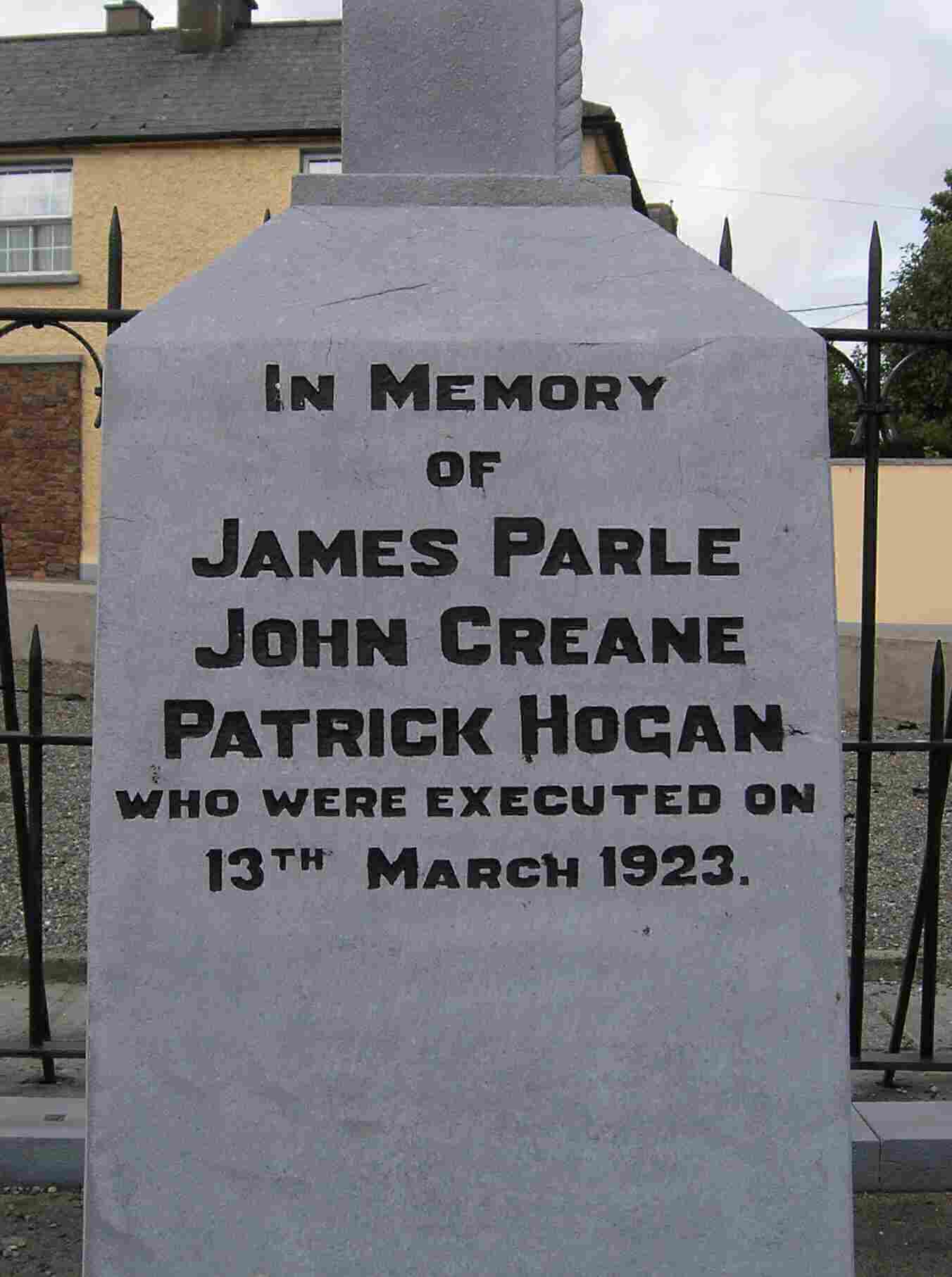
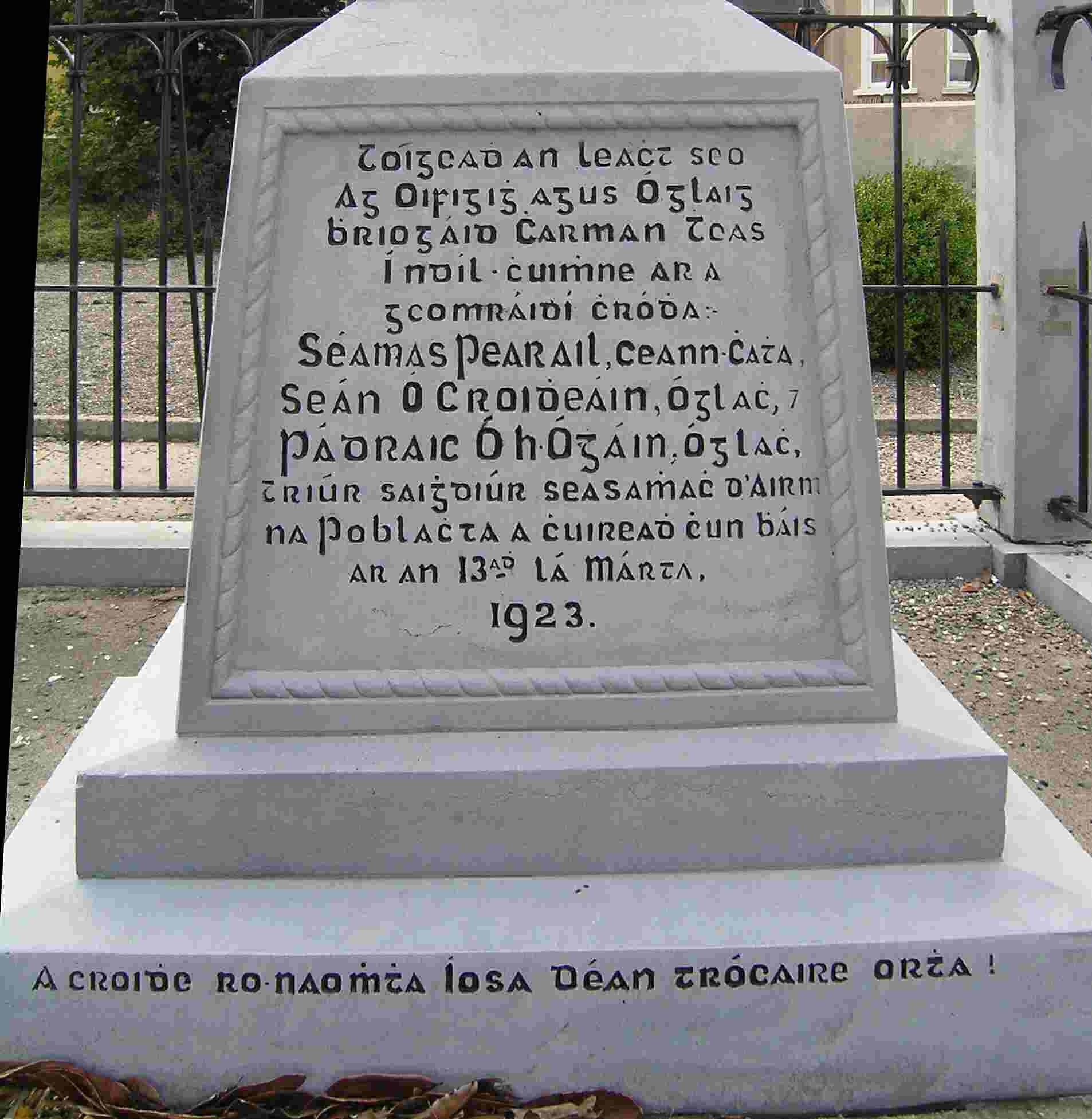
Place of Memorial Taghmon /
On south side of R738 on Wexford side of village.
http://www.irishwarmemorials.ie/Memorials-Detail?memoId=133
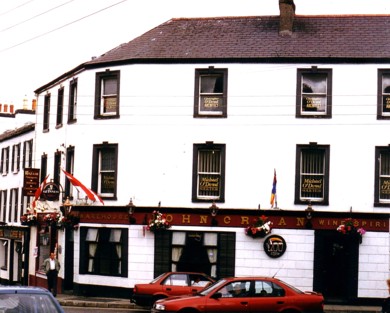
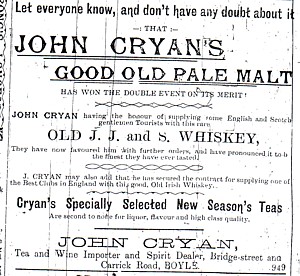
The Roscommon Herald 28-12-1895
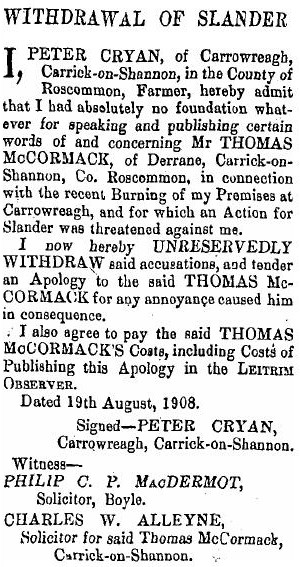
The
Leitrim Observer 22 August 1908
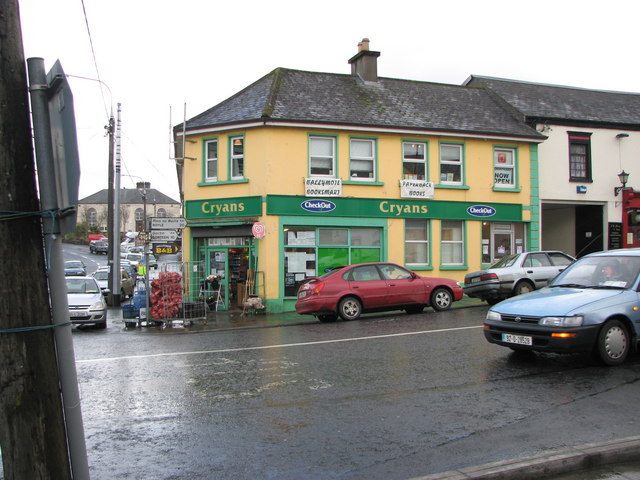
Cryans general store, Ballymote, Co Sligo
https://commons.wikimedia.org/wiki/File:Cryans_general_store,_Ballymote_-_geograph.org.uk_-_1588361.jpg
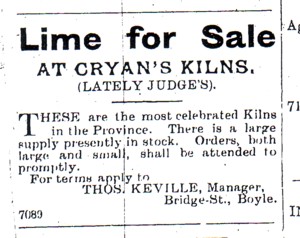
The Roscommon Herald
19-4-1902
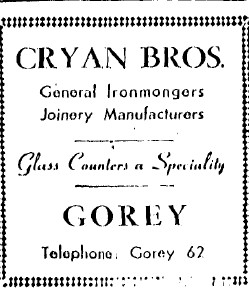
The Irish Times 17 Feb 1951
Ballymote, Co Sligo, Ireland (from Paul Cryan)
M. Cryan's shop c.1938
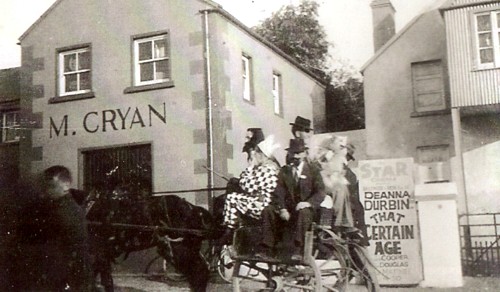
The shop M.Cryan's would have been my grandfather's brother Matts shop in Ballymote Town . The Cinema is next door and I vaguely remember that was owned by his brother Bartholomew (Batty). My father was born in Cryan's confectionery shop next to McDonagh's pub in O'Connell street, now called Doddy's. I believe this is Matt's shop in the photo which would have been in Teeling street.
'That Certain Age' (1938)
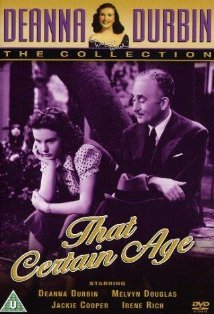
http://www.imdb.com/title/tt0030854/
Invoice for works 1918
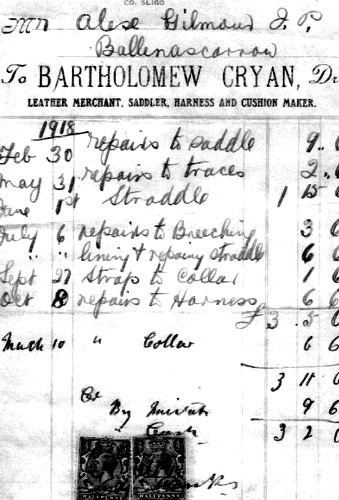
Invoice for works carried out by Cryan's harness makers. My great grand father Michael had a harness/saddler business in Ballymote Town. This was carried on by the oldest brother Patrick when he died (no idea what happened to Patrick) and I can only guess that Bartholomew (Batty) kept it going, although he became and auctioneer/land agent. The harness/saddler business was in New Town Street which I believe is now O'Connell street.
Contact Paul for more info or suggestions:
paulpatrickcryan@googlemail.com
Frances Cryan
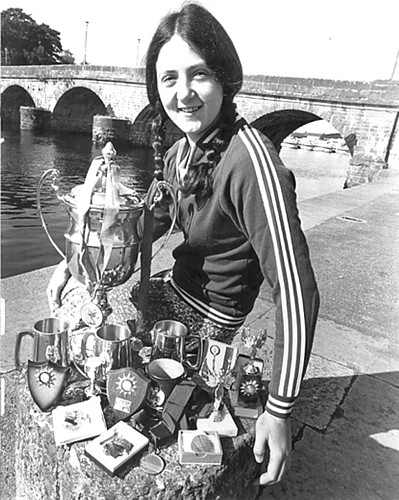
http://www.askaboutireland.ie/learning-zone/primary-students/looking-at-places/leitrim/people-and-places-in-leit/sports-stars-of-leitrim/frances-cryan/
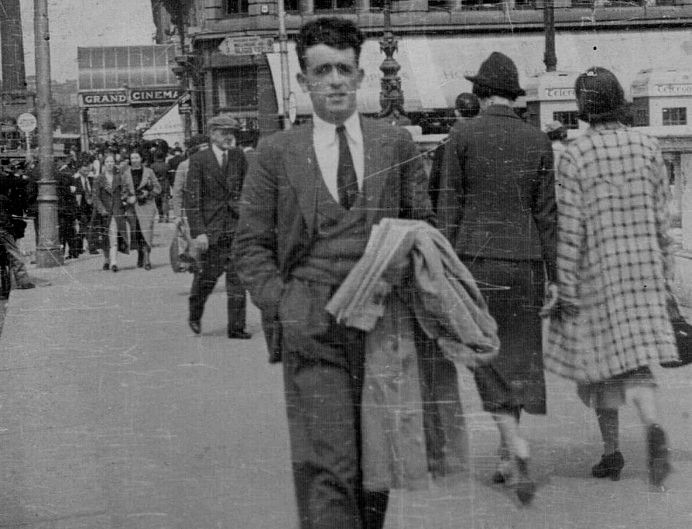
Thomas Cryan
( Avril Cryan )
http://www.manonbridge.ie
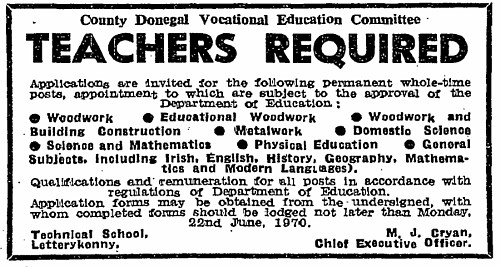
The Irish Times June 1970
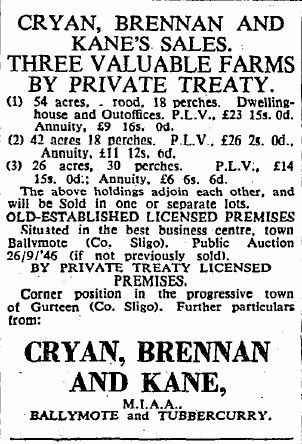
The Irish Times 9 September 1946
Cryan's Hotel -
Carrick on Shannon, Co Leitrim, Ireland
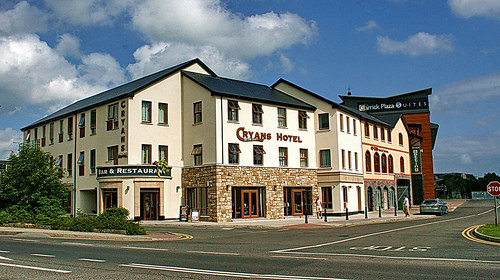
Photo- Martina (77)
'Cryan's Hotel opened in Carrick on Shannon in August 2007. Although the family have been in business in Carrick on Shannon for over 50 years. Having a long established tradition of great hospitality good food and great craic in their famous traditional Irish bar. Cryan's hotel is located right beside the River Shannon and Carrick On Shannon Town Centre.'
https://cryanshotel.ie/
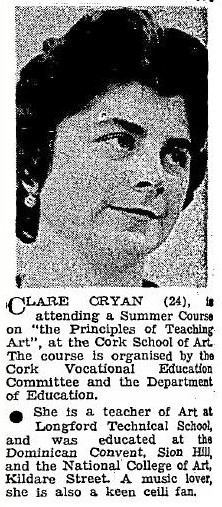
The Irish Press 22 July 1960
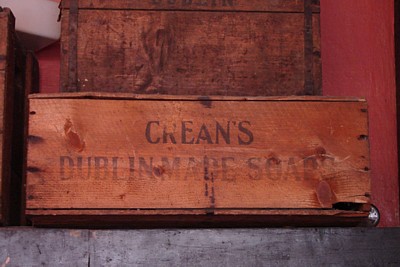
'Crean's Dublin Made Soap'
Tigh Neachtain Pub, Galway (2009)
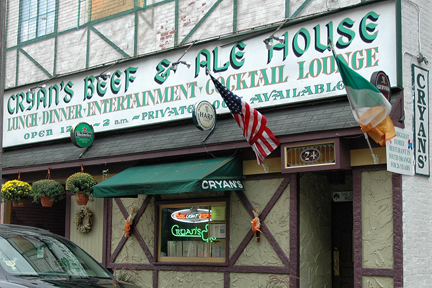
Cryan's Beef and Ale House
24 1st St, South Orange, NJ 07079
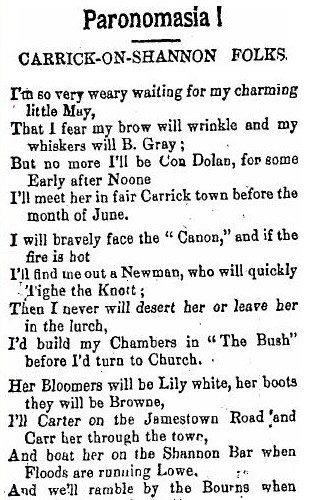
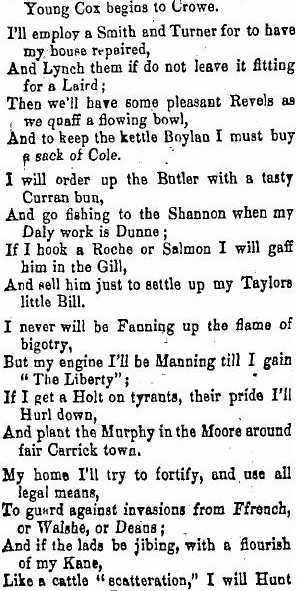
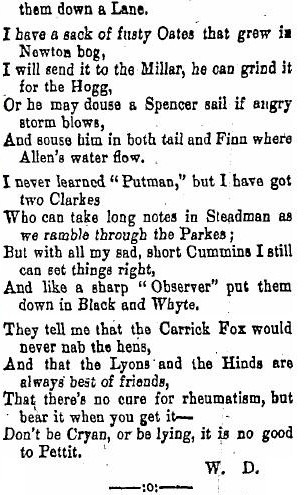
The Leitrim Observer 25 April 1908
